Multiple Choice
Identify the
choice that best completes the statement or answers the question.
|
|
|
A BATTLE OVER THE SUPREME COURT
Civil rights was not the only issue over which President Nixon and the Supreme Court clashed
. During the 1968 campaign, Nixon had criticized the Warren Court for being too liberal. Once in the
White House, Nixon suddenly found himself with an opportunity to change the direction of the court.
During Nixon's first term, four justices, including chief justice Earl Warren, left the bench
through death, retirement, or resignation . President Nixon quickly moved to put a more conservative
face on the Court. In 1969, he appointed U.S. Court of Appeals judge Warren Burger as chief justice.
Burger's Senate confirmation went smoothly. However, Nixon's effort to fill a second
vacancy could not have been rougher. The Senate rejected Nixon's next two nominees-two
conservative Southerners . The Senate claimed that one judge had engaged in questionable business
dealings, while the other one was under qualified.
| Eventually, Nixon
placed on the bench three justices-Harry A. Blackman, William H. Rehnquist, and Lewis Powell-who
tilted the Court in a more conservative direction . However, the newly shaped Court did not always
take the conservative route-for example, it handed down the 1971 ruling in favor of racially
integrating schools through busing
| | |
|
|
|
1.
|
Who appoints people to the
supreme court when there are vacancies?
a. | the Chief
Justice | c. | the
Senate | b. | the President | d. | none of these |
|
|
|
2.
|
Who must approve appointments
to the supreme court?
a. | the
president | c. | the chief
justice | b. | the Senate | d. | the House of Representatives |
|
|
|
3.
|
Nixon tried to appoint
conservatives to the supreme court. Did his appointees always make conservative
rulings?
|
|
|
Nixon Confronts a Stagnant
Economy
One of the more pressing issues facing Richard Nixon
was a troubled economy. Between 1967 and 1973, the nation's inflation rate doubled, from 3
percent to 6 percent. Inflation means that prices are rising. In addition, the unemployment rate, at
nearly 4 percent when Nixon took office, climbed to almost 6 percent by 1971 . Economists referred to
the double hit of rising inflation and unemployment as stagflation. Nixon's attempts to fight
stagflation mostly failed, and the nation's economic downswing would continue on throughout the
1970s, frustrating other administrations as well.
|
|
|
4.
|
In 1971 the U.S. economy
experienced, “stagflation.” What happens during stagflation?
a. | prices rise and unemployment goes
down | c. | prices rise and unemployment
rises | b. | prices fall and unemployment falls | d. | unemployment rises and prices
fall |
|
|
|
THE CAUSES OF STAGFLATION
The economic problems of the late 1960s and early
1970s had several causes . One cause lay in Lyndon Johnson's attempt to pay for the Vietnam War
and the Great Society through massive deficit spending, or spending more money than the government
had collected in taxes . This influx of money into the economy had spurred the growth of inflation.
Second, America had begun losing out in international trade markets to West Germany, Japan, and other
rising industrial powers . Third, the nation could not absorb a flood of new workers-mainly baby
boomers and women into the labor market. Between 1965 and 1980, America's labor force grew by
almost 30 million workers . The number of new jobs could not keep pace, leaving many
unemployed.
Finally, the nation had begun to suffer for its heavy dependency on foreign oil.
America received much of its petroleum from the oil producing countries of the Middle East. Many of
these countries belonged to a cartel called the Organization of Petroleum Exporting Countries, or
OPEC. (A cartel is an organization that controls enough of the production of a commodity to set the
price.) During the 1960s, OPEC gradually raised oil prices . Then in 1973, the Yom Kippur War broke
out, with Israel against Egypt and Syria. When the United States sent massive military aid to Israel,
its longtime ally, the Arab OPEC nations responded by cutting off all oil sales to the United States
.
From the fall of 1973 until March of 1974, when the oil embargo ended, American motorists
faced long lines at gas stations. Across the nation, factories and schools closed . One New England
mother of three lamented that her children were no better off at home . "We'll have heating
problems at home, too," she said. "And I'm not sure I can keep them much warmer
here." Moreover, when OPEC resumed selling its oil to the United States, the price had
quadrupled. This sharp rise in oil prices only worsened the problem of inflation
|
|
|
5.
|
What is it called when the
government spends more money than it takes in through taxes.
a. | inflation | c. | deficit spending | b. | stagflation | d. | none of these |
|
|
|
6.
|
President Johnson dumped a
great deal of money into the economy through government spending. What effect did this have on prices
of products?
a. | made prices
fall | d. | all of
these | b. | made prices rise | e. | none of these | c. | made more products available |
|
|
|
7.
|
What is
OPEC?
a. | an organization of countries that
export oil to the rest of the world | c. | Oil Property Economic Council | b. | an organization of countries that import oil from the rest
of the world | d. | an organization of Arab nations and
Israel |
|
|
|
8.
|
When the middle east countries
cut oil exports to America, what effect did it have on the economy?
a. | gasoline prices went
higher | d. | all of these
happened | b. | there was a shortage of gasoline and oil | e. | none of these happened | c. | home heating oil prices went
higher |
|
|
|
9.
|
Why did the Arab Oil cartel cut
oil supplies to the U.S.?
a. | The U.S. tried to invade
Iraq | c. | The Arab nations were communist and
wanted to defeat capitalist America | b. | the U.S. supported Israel in the Yom Kippur
war | d. | none of
these |
|
|
|
NIXON BATTLES
STAGFLATION
President Nixon took several steps to combat
stagflation, but none met with much success . To reverse deficit spending, Nixon attempted to raise
taxes and cut the budget . Congress, however, refused to go along with this plan. In another effort
to slow inflation, Nixon tried to reduce the amount of money in circulation by urging that interest
rates be raised . This measure did little except drive the country into a mild recession, or an
overall slowdown of the economy.
In August of 1971, the president turned to price and wage
controls to stop inflation. He froze workers' wages as well as businesses' prices and fees
for 90 days. Inflation eased for a short time, but the recession continued.
|
|
|
10.
|
How did Nixon attempt to battle
staglation
a. | raise
taxes | d. | all of
these | b. | cut government spending | e. | none of these | c. | raise interest rates |
|
|
|
11.
|
What did Nixon do to control
inflation?
a. | Nixon took a “hands off”
policy toward the economy in 1971 | d. | Nixon told businesses not to raise wages but allowed them to raise
prices. | b. | Nixon forced businesses to hire more workers | e. | none of these | c. | Nixon ordered companies not to raise wages for workers and not to raise
prices |
|
|
|
Nixon's Foreign Policy
Triumphs
Richard Nixon admittedly preferred world affairs to
domestic policy. "I've always thought this country could run itself domestically without a
president," he had said in 1968 . Throughout his presidency, Nixon's top priority was
gaining an honorable peace in Vietnam . However, he also made significant advances in America's
relationships with China and the Soviet Union.
|
|
|
12.
|
Domestic policies are policies
that refer to things happening inside the United States. Foreign affairs refers to events that are
happening outside of the United States, such as relationships with foreign countries. Which type of
policies did President Nixon prefer to work with?
a. | foreign
affairs | c. | the
economy | b. | domestic policies | d. | civil rights |
|
|
|
KISSINGER AND
REALPOLITIK
The architect
of Nixon's foreign policy was his adviser for national security affairs, Henry Kissinger.
Kissinger, who would later become Nixon's secretary of state, promoted a philosophy known as
realpolitik, from a German term meaning "realistic politics ." In terms of foreign policy,
realpolitik meant dealing with other nations in a practical and flexible manner, rather than by
following a rigid policy . Kissinger believed in evaluating a nation's power, not its
philosophy or beliefs. If a country was weak, Kissinger argued, it was often more practical to
ignore that country, even if it was Communist. | 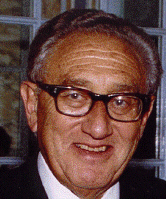 | On the other hand, Kissinger's philosophy called for
the United States to fully confront the powerful nations of the globe . In the world of realpolitik,
however, confrontation meant negotiation as well as military engagement. Realpolitik marked a
departure from the policy of containment, which refused to recognize the world's major Communist
countries. Kissinger urged the United States to recognize and deal directly with these nations. It
was impractical, for example, to deny the existence of mainland China, which contained at least
one-fifth of the world's population . It also was impractical not to ease relations with the
Soviet Union, with its massive stockpile of nuclear weapons. Nixon shared Kissinger's
belief in realpolitik, and together the two men adopted a more flexible approach in dealing with
Communist nations . They called their policy detente-a policy aimed at easing Cold War tensions . One
of the most startling applications of detente came in early 1972 when President Nixon-who had risen
in politics as a strong anti-Communist-visited Communist China.
| | |
|
|
|
13.
|
Nixon and Kissinger believed
that the U.S. needed to deal with all powerful countries in a practical way, even if they were
dictatorships. What was this philosophy called?
a. | human rights
| c. | capitalism | b. | socialism | d. | realpolitik |
|
|
|
14.
|
Nixon was an anti-communist but
because he believed in realpolitik he was able to visit and negotiate with
a. | Communist
China | c. | both China and the
Soviets | b. | the Soviet Union | d. | neither China nor the Soviets |
|
|
|
15.
|
Nixons policy for easing the
tensions between the United States, Communist China and the Soviet Union through negotiation was
called
a. | detente | c. | the Marshall Plan | b. | the Truman Doctrine | d. | the capitulation |
|
|
|
16.
|
From what we have learned about
Nixon and Kissinger, we can assume that they were _____ politicians.
a. | ideological | c. | rigid | b. | extremist | d. | practical |
|
|
|
NIXON VISITS CHINA
Since the
takeover of mainland China by the Communists in 1949, the United States had not formally recognized
the Chinese Communist government . In late 1971, Nixon reversed that policy. In a 90- second
television speech, the president announced that he would visit China "to seek the normalization
of relations between the two countries and to exchange views on questions of concern to both
sides." By going to China, Nixon was trying, in part, to take advantage of the decade-long
rift between China and the Soviet Union. China had long criticized the Soviet Union as being too
"soft" in its policies against the West. The two Communist superpowers officially broke
ties in 1960. Nixon had thought about exploiting the fractured relationship for several years.
"We want to have the Chinese with us when we sit down and negotiate with the Russians," he
told a reporter in 1968. Nixon's visit to Beijing in February of 1972 scored high marks
from the American public .U.S. television crews flooded American living rooms with news reports and
film clips of Nixon at the Great Wall of China, at the Imperial Palace, and even toasting top
Communist leaders at state dinners. Observers noted that an important reason for the trip's
popularity back home was Nixon's strong anti- Communist background . It |

Nixon and Mao
seemed that Nixon, and no
one else, could convince the American people that the time was right to negotiate with the
Communists Besides the trip's enormous symbolic value, it also resulted in important
agreements between the United States and China. The two nations agreed that neither would try to
dominate the Pacific and that both would cooperate in settling disputes peacefully. The two nations
also agreed to participate in scientific and cultural exchanges as well as to eventually reunite
Taiwan with the mainland . | | |
|
|
|
17.
|
There is a phrase, often used
in political discussions, that says, “Only Nixon could go to China.” What does that
phrase mean?
a. | The American people might not trust
a liberal politician to go to China because liberals might not stand up to the
communists | c. | means neither of
these | b. | The American people trusted Nixon to negotiate with Communist China because he
was so anti-communist | d. | means both of
these |
|
|
|
18.
|
What did the U.S. and China
agree to because of Nixon’s trip to China?
a. | cooperate in settling disputes
peacefully | d. | neither would try
to dominate the Pacific | b. | eventually reunite Taiwan with the mainland China | e. | all of these | c. | scientific and cultural exchanges |
|
|
|
19.
|
Communist China was a sworn
enemy of the United States for many years. Why did Nixon go to China?
a. | he wanted to drive a wedge between
the Soviet Union and China | c. | he was an ideological politician | b. | he was afraid of the technology of
China | d. | he was plotting to attack North Korea and wanted
China’s help |
|
|
|
20.
|
When did the communists take
over mainland China?
a. | 1949 | c. | 1960 | b. | 1952 | d. | the communists did not take over mainland china, they took over
Taiwan |
|
|
|
21.
|
The majority of American people
_______ Nixon’s trip to China
a. | opposed | c. | supported | b. | did not care about | d. | protested |
|
|
|
NIXON TRAVELS TO MOSCOW
In May of 1972, three months after visiting Beijing,
President Nixon headed to Moscow-the first U.S . president ever to visit the Soviet Union. By the
time the president arrived for a summit meeting with Soviet premier Leonid Brezhnev, relations with
the Soviet Union had already warmed. In 1971, the United States and the Soviet Union had crafted an
agreement about Berlin . The Soviets promised to guarantee Western nations free access to West Berlin
and to respect the city's independence . In return, the Western allies agreed to officially
recognize East Germany.
Like his visit to China, Nixon's trip to the Soviet Union
received wide acclaim. After a series of meetings called the Strategic Arms Limitation Talks (SALT),
Nixon and Brezhnev signed the SALT I Treaty. This five-year agree ment limited the number of
intercontinental ballistic missiles (ICBMs) and submarine-launched missiles to 1972 levels
.
| 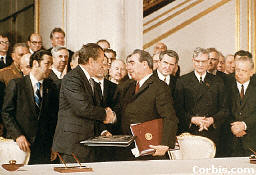
The foreign policy
triumphs with China and the Soviet Union, which came just months before the 1972 presidential
election, helped Nixon win a second term in the White House. The administration's announcement
October of 1972, that peace was imminent in Vietnam also played a significant role in Nixon's
reelection.
However, peace in Vietnam proved elusive, and the Nixon administration grappled
with the war for nearly six more months before finally ending America's involvement in Vietnam.
By that time, another issue was about to dominate the Nixon administration- one that eventually led
to the downfall of the president.
| | |
|
|
|
22.
|
What was the First Strategic
Arms Limitation Treaty about?
a. | open access to Berlin in East
Germany | c. | opening trade with
the Soviets | b. | freeing Poland | d. | limiting nuclear missiles |
|
|
|
23.
|
We can safely assume that
Nixon’s trips to China and the Soviet Union
a. | was opposed by most people in the
world | c. | made world war more
likely | b. | promoted peace in the world | d. | made the U.S. weaker |
|
|
|
24.
|
After Nixon visited Communist
China and the Soviet Union, North Vietnam quickly agreed to peace in Vietnam
|
|
|
25.
|
The trips to the Soviet Union
and China _____ Nixon in the 1972 presidential election.
a. | had no effect on
| c. | helped | b. | hurt |
|
|
|
26.
|
The foreign policy of dtente
was mainly intended
to
a. | contain
communism. | c. | increase
international respect for human rights | b. | ease Cold War tensions | d. | raise U.S. prestige among the international
community. |
|
|
|
27.
|
With what nation did the United
States sign the SALT I Treaty?
a. | Iran | c. | the Soviet Union | b. | Afghanistan | d. | the People’s Republic of
China |
|
|
|
28.
|
What did Henry Kissinger
believe should be the main
consideration of the United States in conducting relations with another
nation?
a. | that nation’s
power | c. | the political beliefs of that
nation’s leaders | b. | that nation’s geographical location | d. | the respect shown for human rights by that nation’s
leaders |
|
|
|
29.
|
In 1972, the
“plumbers” were caught breaking into the offices of
a. | OPEC | c. | the Democratic National
Committee | b. | the CIA | d. | the Committee to Reelect the
President |
|
|
|
30.
|
Who presided over the trial of
the Watergate “plumbers”?
a. | Sam
Ervin | c. | John
Sirica | b. | John Dean | d. | G. Gordon Liddy |
|
|
|
31.
|
President Nixon’s
resignation most directly followed the
a. | Saturday Night
Massacre. | c. | release of taped
presidential conversations. | b. | resignation of Vice-President Agnew. | d. | indictment of Mitchell, Haldeman, and
Ehrlichman |
|
|
|
32.
|
All of the following were
forced to resign from office by the Watergate scandal except
a. | Spiro
Agnew. | c. | John
Ehrlichman | b. | H. R. Haldeman | d. | Richard M. Nixon |
|
|
|
33.
|
Which of the following was the
foundation of President Ford’s foreign policy?
a. | human
rights | c. | the containment of
communism | b. | the continuation of dtente | d. | reducing the cost of foreign oil |
|
|
|
34.
|
Which of the following did
President Carter believe was the most important domestic problem faced by the United
States?
a. |
inflation | c. | civil
rights | b. | the energy crisis | d. | poverty and homelessness |
|
|
|
35.
|
Who was the leader of a
revolutionary government in Iran with which the United States eventually cut off diplomatic
relations?
a. | Anwar
Sadat | c. | Mohammed
Pahlavi | b. | Menachem Begin | d. | Ayatollah Ruhollah Khomeini |
|
|
|
36.
|
The main goal of President Nixon’s New Federalism
was to
a. | restore law and order to the
nation | c. | limit the power of the Supreme
Court | b. | increase the power of the presidency | d. | reduce the power of the federal
government. |
|
|
|
37.
|
During the 1970s, a number of
nations formed OPEC in order to
a. | control
inflation | c. | reduce the risk of
nuclear weapons. | b. | control the price of oil. | d. | set standards to protect the
environment |
|
|
|
38.
|
During Nixon’s
presidency, the United States first officially recognized
a. | Israel | c. | Taiwan. | b. | the Soviet Union | d. | the People’s Republic of
Chin |
|
|
|
39.
|
The Watergate cover-up began
immediately after
a. | the burglars were
arrested | c. | the trial for the
burglars began | b. | the burglars were convicted. | d. | the Committee to Reelect the President was
formed. |
|
|
|
40.
|
To which of the following were
the “plumbers” most
closely connected?
a. | the FBI | c. | the White House | b. | the CIA | d. | the Democratic Party |
|
|
|
41.
|
Who gave the order that
resulted in the Saturday Night Massacre?
a. | John
Dean | c. | John
Mitchell | b. | Richard M. Nixon | d. | Eliot Richardson |
|
|
|
42.
|
Which of the following reflects
the correct chronological order?
a. | “plumbers”
arrested
Nixon reelected
articles of impeachment adopted
Nixon
resigns
Nixon pardoned | c. | Nixon reelected
“plumbers” arrested
Nixon
resigns
Nixon
pardoned
rticles of impeachment
adopted | b. | “plumbers” arrested
Nixon reelected
Nixon
resigns
articles of impeachment adopted
Nixon
pardoned | d. | Nixon reelected
“plumbers” arrested
Nixon resigns
articles of impeachment adopted
Nixon pardoned |
|
|
|
43.
|
Gerald Ford was responsible for
all of the following except
a. | vetoing more than 50 pieces of
legislation | c. | the “Whip
Inflation Now” program. | b. | negotiating the SALT I Treaty. | d. | the continued easing of Cold War
tensions |
|
|
|
44.
|
9. Which of the following was
the most significant element in Jimmy Carter’s foreign policy ?
a. | realpolitik | c. | human rights issues | b. | energy issues | d. | the containment of communism |
|
|
|
45.
|
Who adopted the Southern
strategy in the hopes of winning election?
a. | Gerald
Ford | c. | Henry
Kissinger | b. | Jimmy Carter | d. | Richard M. Nixon |
|
|
|
Richard Nixon came to the office of President vowing to help heal the deep divisions
and social conflicts of the 1960’s. He wanted to bring America together. In some ways he did
help to heal the divisions of the 1960’s and in other ways he did not.
It was November
of 1968 and Richard M. Nixon had just been elected president of the United States . President-elect
Nixon asked Henry Kissinger to be his special adviser on foreign affairs . Kissinger did not
particularly like Nixon, but he accepted, telling a surprised colleague, "I'm working for
the presidency, not for Richard Nixon personally." However, in time the two men grew to be
trusting colleagues . At the beginning of Nixon's second term in 1972, as the United States
struggled to achieve an honorable peace in Vietnam, Kissinger finally came to respect Nixon for his
vision and the two men did a great deal to promote world peace. They ended the Vietnam War and laid
the foundation for the end of the cold war.
Nixon and Kissinger ended America's
involvement in Vietnam. As the war wound down, the nation seemed to enter an era of limits . There
were limits to U.S . power, as the nation's military had not been able to save South Vietnam
from becoming Communist . Lyndon Johnson's Great Society programs seemed limited in their
ability to eliminate poverty. And as the 1970s progressed, there seemed to be limits to the economic
prosperity that the nation had experienced since World War II .
Into this era stepped a
president who believed that there were also limits to what the federal government could accomplish.
President Nixon would take action to reduce the power of the federal .government (the U.S.
government) and reverse the liberal policies of Lyndon Johnson. At the same time, he would seek to
restore America's prestige and influence on the world stage-prestige that had been hit hard by
the Vietnam experience .
| 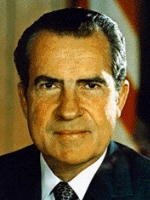
Richard Nixon

Henry
Kissinger | | |
|
|
|
46.
|
What job did Henry Kissinger do
for Richard Nixon?
a. | Secretary of the
Treasury | c. | Presidential
Secretary | b. | Chairman of the Joint Chiefs of Staff | d. | Special advisor on foreign
affairs |
|
|
|
47.
|
Which president ended the
Vietnam War?
a. | Lyndon
Johnson | c. | Henry
Kissinger | b. | Richard Nixon | d. | John Kennedy |
|
|
|
48.
|
Which statement is
true?
a. | Richard Nixon tried to expand the
Great Society programs started by President Johnson | d. | Richard Nixon worked to make the U.S. government
bigger | b. | Richard Nixon realized there were limits on what the government could do and
tried to limit the growth of Great Society programs | e. | None of these statements are true | c. | Richard Nixon did not care about domestic policies
|
|
|
|
49.
|
Which statement is
true?
a. | The United States was able to
prevent Vietnam from uniting under communism | d. | none of these statements are true | b. | The United States was able to prevent South Vietnam from
becoming communist | e. | all of these statements are
true | c. | In spite of the efforts of the United States, all of Vietnam became
communist |
|
|
|
50.
|
What did the Watergate scandal
center on?
a. | bribes taken by Nixon and members of
his administration | c. | Nixon’s
attempt to purchase the Watergate hotel | b. | the Nixon administration attempt to cover up a burglary at the Watergate
hotel | d. | none of
these |
|
|
|
Nixon's New
Conservatism
A liberal
can be described as someone who is in favor of a bigger central government. A conservative is someone
who favors a smaller central government with more power going to the states and local communities.
President Richard M. Nixon entered office determined to turn America in a more conservative direction
. Toward that end, he decreased the power of the federal government, dismantled a number of Great
Society programs, and tried to instill a sense of order into a nation still divided over the
continuing Vietnam War.
| |
|
|
|
51.
|
Richard Nixon was a _____ while
Lyndon Johnson was a _____ .
a. | conservative -
liberal | c. | liberal -
liberal | b. | liberal - conservative | d. | conservative -
conservative |
|
|
|
52.
|
Conservatives think the Federal
(U.S.) government should be
a. | bigger | c. | about the same size | b. | smaller | d. | not an issue for conservatives |
|
|
|
NEW FEDERALISM'S TWO FACES
In
the end, Nixon's New Federalism enhanced several key federal programs as it dismantled others .
Nixon was a Republican and the Congress was controlled by the Democrats. With the House and Senate in
the hands of Democratic majorities, Nixon initially sought compromise on Capitol Hill as he attempted
to move ahead with his New Federalism program. For example, Nixon supported a number of measures to
increase federal spending for some social programs. Without fanfare, the Nixon administration
increased Social Security, Medicare, and Medicaid payments and made food stamps more accessible.
Nixon also supported subsidized housing for low- and middle-income families, and he expanded the
nation's job Corps program. Because he performed these actions quietly, he did not receive much
credit for these attempts to help the poor.
However, the spirit of compromise between Congress
and the White House soon deteriorated. Confronted by laws that he opposed, Nixon turned to a
little-used presidential practice called impoundment. Nixon impounded, or refused to spend
money for programs he opposed, thus holding up their implementation . By 1973, Nixon had impounded
almost $15 billion, affecting more than 100 federal programs, including those for health, housing,
and education.
The federal courts eventually ordered the release of the impounded funds. They
ruled that presidential impoundment was unconstitutional and that only Congress had the authority to
decide how federal funds should be spent. However, in 1973 Nixon did use his presidential authority
to abolish the Office of Economic Opportunity, a cornerstone of Johnson's antipoverty
program.
| The white house (the president) and the congress.
Two branches of government that are sometimes in conflict with each other over
issues
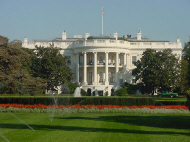
The White House (President)
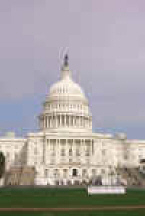
The Capital Building
(Congress) | | |
|
|
|
53.
|
Which statement is
true
a. | Nixon tried to compromise with
congress by expanding many social welfare programs | c. | Nixon did not need to compromise with congress because he was a Republican and
the Republicans controlled congress | b. | Nixon made no attempt to compromise with
congress | d. | Nixon was a Democrat and the
congress was controlled by the Republicans |
|
|
|
54.
|
Why didn’t Nixon receive
credit for his attempts to increase social welfare programs and help the poor?
a. | Nixon did not do anything to help
the poor | c. | Nixon worked
quietly to help the poor | b. | Nixon was not good on TV | d. | None of these are true |
|
|
|
55.
|
When congress passed laws that
President Nixon did not agree with, he just refused to spend the money so the laws never went into
effect. What was this tactic called?
a. | rescission | c. | filibuster | b. | impoundment | d. | veto |
|
|
|
LAW-AND-ORDER POLITICS
As
President Nixon fought with Congress, he also battled the more liberal elements of society, including
the antiwar movement. Nixon had been elected in 1968 on a dual promise to end the war in Vietnam and
mend the divisiveness within America that the war had created. Throughout his first term, Nixon
aggressively moved to fulfill both these pledges. The president de-escalated America's
involvement in Vietnam and oversaw peace negotiations with North Vietnam. At the same time, he began
the "law and order" policies that he had promised his "silent majority"-those
middle-class Americans who wanted order restored to a country beset by urban riots and antiwar
demonstrations .
To accomplish this goal, Nixon used the full resources of his
office-sometimes illegally. The FBI illegally wiretapped numerous left-wing individuals and
organizations. The FBI also infiltrated the ranks of the Students for a Democratic Society and
radical African-American groups in an effort to spread conflict within the
organizations.

Vice President
Spiro Agnew | 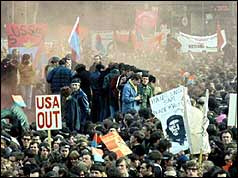
In addition, the CIA investigated and compiled documents on thousands of American
dissidents-people who objected to the government's policies . The administration even used the
Internal Revenue Service to audit the tax returns of antiwar and civil rights activists. Viewing his
opponents as personal assailants, Nixon began building an "enemies list" of prominent
Americans whom the administration would harass . Remarked a top White House official, "anyone
who opposes us, we'll destroy."
Nixon also enlisted the help of his combative
vice-president, Spiro T. Agnew. In the fall of 1969, Nixon sent Agnew on a public speaking tour to
attack the opposition . The vice-president repeatedly denounced the antiwar protesters and then
turned his scorn on those who controlled the media, whom he viewed as liberal cheerleaders for the
antiwar movement. Known for his colorful quotes, Agnew lashed out at the media and liberals as
"an effete [weak] corps of impudent snobs," and "nattering nabobs of
negativism ." | | |
|
|
|
56.
|
What two promises did Nixon
make when he became president?
a. | Continue the Great Society programs
of the Johnson administration and end the war in Vietnam | c. | End the war in Vietnam and build-up the American
military | b. | Make the government bigger and heal the problems in American
society. | d. | End the war in Vietnam and heal the
divisions in American Society by bringing the people
together. |
|
|
|
57.
|
Who was the “silent
majority?”
a. | the majority of Americans who did
not protest the war or riot, and wanted law and order in American
society. | c. | the majority of
the Anti-war movement who wanted to take a more violent approach in their
protests | b. | the majority of the civil rights movement who wanted the movement to be more
confrontational (violent) | d. | the young people in
America |
|
|
|
58.
|
Nixon set out to infiltrate,
undermine and destroy the anti-war movement in America. Which government agency did he use to achieve
this goal?
a. | CIA | d. | all of these agencies | b. | FBI | e. | none of these agencies | c. | IRS |
|
|
|
59.
|
Nixon believed that the liberal
news media (TV, Newspapers and magazines) were supporting the anti-war movement. What did Nixon do to
combat the liberal news media?
a. | He remained quiet on the
issue | c. | He tried to jail the major liberal
publishers | b. | Sent Vice President Agnew to attack the liberal
media. | d. | He tried to make friends with the liberal
media |
|
|
|
Nixon's Southern
Strategy
Even as President
Nixon worked to steer the country along a more conservative course, he had his eyes on the 1972
presidential election. Nixon had won a slim majority in 1968-less than one percent of the popular
vote . Shortly after entering the White House, he began working to forge a new conservative coalition
to build on his support. In one approach, known as the Southern strategy, Nixon tried to attract
Southern conservative Democrats by appealing to their unhappiness with federal desegregation policies
and a liberal Supreme Court.
|
|
|
60.
|
In the Southern Strategy, Nixon
tried to get unhappy Southern Democrats to turn Republican so he would get more votes in the next
election in 1972. What were the Southern Conservative Democrats unhappy about?
a. | too much
welfare | c. | desegregation and
liberal Federal courts | b. | the Vietnam war | d. | segregation and voting rights |
|
|
|
A NEW
SOUTH
Since Reconstruction, the South had been a Democratic
stronghold . But by 1968 many white Southern Democrats had grown disillusioned with their party. In
their eyes, the party champion of the Great Society and civil rights-had grown too liberal. -`This
conservative backlash first
surfaced in the 1968 election, when thousands of Southern Democrats helped former Alabama governor
George Wallace, a conservative segregationist running as an independent, carry five Southern states
and capture 13.5 percent of the popular vote.
Nixon wanted these voters . By winning over the
Wallace voters and other discontented Democrats, the president and his fellow Republicans hoped not
only to keep the White House but also to recapture a majority in Congress .
NIXON
SLOWS INTEGRATION
To attract white voters in the South, President Nixon decided on a
policy of slowing the country's desegregation efforts . In September of 1969, shortly after
being elected president, Nixon made clear his views on civil rights ."There are those who want
instant integration and those who want segregation forever. I believe we need to have a middle course
between those two extremes," he said.
|
|
|
61.
|
What was Nixon’s view on
racial integration?
a. | He believed we should have
integration but it should move more slowly. | c. | He believed we should have integration right
away. | b. | He was against racial integration | d. | He believed that the civil rights movement was part of a communist
plot |
|
|
|
62.
|
The southern Democrats who
became unhappy with the Democrat party because of the liberal direction of the government became
known as the ______
a. | Great
Society | c. | civil rights
movement | b. | Johnson Democrats | d. | conservative backlash |
|
|
|
Throughout his first term,
President Nixon worked to reverse several civil rights policies. In 1969, he ordered the Department
of Health, Education, and Welfare (HEW) to delay desegregation plans for school districts in South
Carolina and Mississippi . Nixon's actions violated the Supreme Court's second Brown v.
Board of Education ruling-which called for the desegregation of schools "with all deliberate
speed." In response to an NAACP suit, the high court ordered Nixon to abide by the second Brown
ruling . The president did so and by 1972, nearly 90 percent of children in the South attended
desegregated schools, up from about 20 percent in 1969.
Nixon also opposed the extension of the Voting Rights Act of 1965. The act
had added nearly one million African Americans to the voting rolls. Despite the president's
opposition, Congress voted to extend the act.
|
|
|
63.
|
Which statement is
true?
a. | Nixon supported almost all of the
civil rights goals of the NAACP | c. | Nixon thought the civil rights movement was part of a communist
plot | b. | Nixon tried to delay the enforcement of civil rights laws to attract Southern
white voters to the Republican party | d. | Nixon tried to delay the encforcement of civil rights laws to attract Southern
white voters to the Democrat party |
|
|
|
64.
|
In the 1960’s less than
20% of African American kids in the south attended integrated schools. By 1972 _____ of African
American kids attended integrated schools in the south.
|
|
|
65.
|
How many African Americans were
added to the voting roles by the Voting Rights Act in the early seventies?
a. | about 1
million | c. | about 10
million | b. | about 5 million | d. | 90% of African Americans |
|
|
|
President Nixon then attempted
to thwart yet another civil rights initiative-the integration of schools through busing. In 1971, the
Supreme Court ruled in Swann v. Charlotte-Mecklenburg Board of Education that school districts may
bus students to other schools to end the pattern of all-black or all-white educational institutions .
Busing meant removing students from their home schools and sending them across town to other schools
in order to integrate. White students and parents in cities such as Boston and Detroit angrily
protested busing. They did not want their children removed from their neighborhood schools and sent
to inner-city schools across town. South Boston became the scene for many protests that were
televised across the country. Busing was very unpopular with the American
people.
Nixon also opposed
integration through busing and went on national television to urge Congress to halt the practice .
While busing continued in some cities, Nixon had made his position clear to the country-and to the
South
.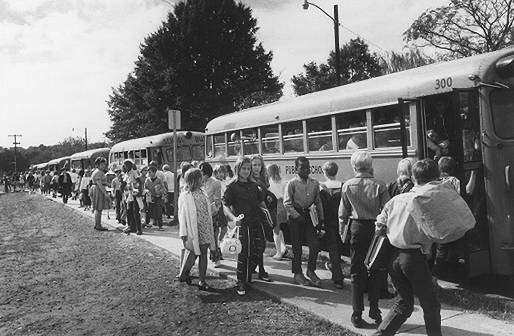
|
|
|
66.
|
Which statement is
true?
a. | Bussing meant transferring students
from their home schools to schools in other parts of the city | d. | all of these statements are
false | b. | The purpose of bussing was to integrate schools that were “all
white” or “all black” | e. | all of these statements are true | c. | The Supreme court ordered bussing, in spite of the fact
that most Americans opposed it. |
|
|
|
67.
|
Nixon’s position on
bussing made him ______ in the south.
a. | popular | c. | neutral on busing | b. | unpopular | d. | none of these statements are
true |
|
|
|
68.
|
Liberals were _____ of bussing,
while conservatives were _____ busing.
a. | against - in favor
of | c. | against -- neutral
on | b. | in favor -
against | d. | neutral on -
against |
|
|
|
69.
|
Only the south was opposed to
bussing. The north accepted it.
|
|
|
AN IMPERIAL PRESIDENCY
The
U.S. Government is made up of three branches, the president, the congress and the supreme court. Over
the course of the nation's history, the balance of power has shifted between these branches of
the federal government. Sometimes the president is more powerful and sometimes the congress is more
powerful. By the time Richard Nixon took office, the executive branch-(president) as a result of the
Great Depression, World War II, and the Cold War-had become the most powerful branch. In his book The
Imperial Presidency, the historian Arthur Schlesinger, Jr., argued that by the time of Richard Nixon,
the executive branch had taken on an air of imperial, or supreme, authority.
President Nixon
settled into this imperial role with ease . Nixon believed, as he told a newspaper reporter in 1980,
that "a president must not be one of the crowd. . . . People . . . don't want him to be
down there saying, `Look, I'm the same as you."' Like Franklin Roosevelt, Nixon
expanded the power of the presidency and gave little thought to constitutional checks, as when he
impounded funds for federal programs he opposed and ordered U.S . troops to invade Cambodia without
congressional approval .
Franklin Roosevelt acted in much the same way. When the Supreme Court
ruled that many of FDR’s New Deal programs were unconstitutional, he tried to pack the court
with extra judges so they could not rule against him.
| Two Imperial presidents:
FDR and Nixon
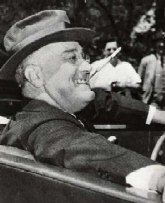
FDR
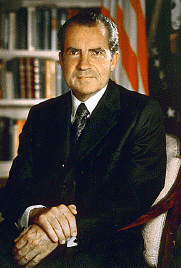
Richard Nixon | | |
|
|
|
70.
|
Which answer below is
not a branch of the U.S.
government?
a. | president | c. | congress | b. | supreme court | d. | the states |
|
|
|
71.
|
Which statement below is
true?
a. | each branch of government always has
the same power | c. | according to the
Constitution the supreme court is more powerful than the president or
congress | b. | only the power of the president changes. The power of congress always stays
the same. | d. | The constitution says that each
branch of government is equal but over time the real power of one of the branches can
change |
|
|
|
72.
|
The
historian Arthur Schlesinger, Jr., argued that by the time of Richard Nixon, the executive branch had
taken on an air of imperial, or supreme, authority. What does this mean?
a. | When Richard Nixon came to office
the president was out of power | c. | The president of the U.S. had no power any
longer | b. | When Richard Nixon came to office the president was like a
king | d. | By the time of Richard Nixon presidents were no longer
elected, they were appointed. |
|
|
|
73.
|
Which statement would Nixon
most likely make?
a. | people do not look up to their
presidents | c. | It is better to be
respected than loved | b. | presidents do not deserve any respect | d. | it is better to be loved than
respected |
|
|
|
|
|
|
74.
|
What did Nixon’s advisors
believe about the law.
a. | they could control the law and
protect their power | d. | all of
these | b. | the law should be respected at all times | e. | none of these | c. | the law should be obeyed at all
times |
|
|
|
A BUNGLED BURGLARY
In 1972
Richard Nixon ran for re-election. His opponent was Senator George McGovern. A large number of
McGovern supporters were left wing radicals who were opposed to the war in Vietnam. Many of the young
radicals were also supporters of North Vietnam, even though North Vietnam was at ware with U.S.
forces. The North Vietnamese were also holding many Americans prisoner.
During his first
administration, the Nixon White House organized a group of young investigators to stop government
secrets from leaking out of the white house and state department. The group was called the
“Plumbers.” During the 1972 campaign this group was put to work for the Nixon political
campaign.
The Plumbers thought that the radicals in the McGovern campaign might be
coordinating activities with the North Vietnamese to help McGovern get elected. McGovern was a
patriotic American and the idea that he would have anything to do with North Vietnam was
preposterous. There is also no evidence that Nixon thought that McGovern was working with North
Vietnam.
The Plumbers, on the other hand, did suspect the McGovern campaign so they broke into
the Democratic Party headquarters in the Watergate Hotel looking for evidence. In the first break-in
they found nothing. |
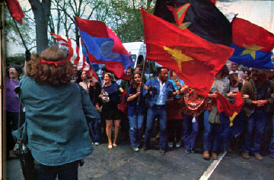 Anti-war protestors show support for North Vietnam by
flying Vietcong and North Vietnam flag Anti-war protestors show support for North Vietnam by
flying Vietcong and North Vietnam flag
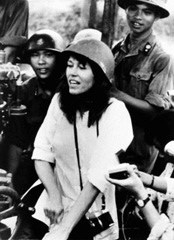
Jane Fonda sits on a North
Vietnam anti-aircraft gun aimed at American airplanes | | |
|
|
|
75.
|
Who were the
Plumbers?
a. | Federal workers who fixed the
plumbing in federal buildings | c. | A group of people who worked to stop information leaks in the white
house | b. | Pro-communist demonstrators | d. | A group of people who secretly sent leaked information to the media and
congress |
|
|
|
76.
|
Who was the Democrat candidate
for president in 1972?
a. | Richard
Nixon | c. | Jimmy
Carter | b. | George McGovern | d. | Spiro Agnew |
|
|
|
77.
|
What did the Plumbers suspect
about the Democrat party?
a. | the Democrats might be sending money
to the North Vietnamese | c. | some people in the
McGovern campaign might be working with the South Vietnamese | b. | some people in the McGovern campaign might be working with
the North Vietnamese | d. | Democrats might be leaking secret
information to the press and congress |
|
|
|
78.
|
What was the
Watergate?
a. | A town close to Washington
D.C. | c. | A hotel where George McGovern
stayed | b. | A hotel that contained offices of the democrat
party | d. | A hotel where the offices of the Plumbers
were |
|
|
|
79.
|
Who was the Republican
Candidate for president in 1972?
a. | George
McGovern | c. | Richard
Nixon | b. | Spiro Agnew | d. | Jimmy Carter |
|
|
|
The Second Watergate
Break-in
At 2:30 A.M ., June 17, 1972, a guard at the Watergate complex in Washington, D
.C ., caught five men breaking into the campaign headquarters of the DNC (Democrat National
Committee). . The burglars had intended to photograph documents outlining Democratic Party strategy
and to place wiretaps, or "bugs," on the office telephones . The press soon discovered that
the group's leader, James McCord, was a former CIA agent. He was also an official of a group
known as the Committee to Reelect the President (CRP). John Mitchell, who had resigned as attorney
general to run Nixon's reelection campaign, was the CRP's director.
Richard Nixon
did not know about the break-in and evidence shows he did not participate in the planning. There is
evidence to show that Nixon found out about the break-in a few days after it happened and tried to
cover it up.
At this point, the White House might have disowned the entire operation and
demanded the resignation of everyone involved. If Nixon had done that the situation would have been
solved. But instead, Nixon tried to cover up the break-in. The cover-up quickly began. Workers
shredded all incriminating documents in Haldeman's office. The White House, with President
Nixon's consent, asked the CIA to urge the FBI to stop its investigations into the burglary on
the grounds of national security. In addition, the Nixon campaign passed out nearly $500,000 to the
Watergate burglars to buy their silence after they were indicted in September of
1972.
Throughout the 1972 campaign, the Watergate burglary generated little interest among the
American public and media. Only the Washington Post and two of its reporters, Bob Woodward and Carl
Bernstein, worked on the story. In a series of articles, the reporters uncovered information that
linked numerous members of the Nixon White House to the burglary. The White House denied each new
allegation.
In light of efforts for world peace, his China and Soviet Union summits and his
promise of peace in Vietnam-Richard Nixon scored the largest victory of any Republican presidential
candidate in history. The president captured nearly 61 percent of the popular vote on his way to
soundly defeating George S. McGovern, a liberal senator from South Dakota. However, as Nixon savored
his landslide victory, the storm clouds of Watergate were gathering on the horizon .
| |
|
|
|
80.
|
James McCord and the other
Watergate burglars were linked to
a. | the McGovern
campaign | c. | the Nixon
Congress | b. | the Congress | d. | the Nixon White House |
|
|
|
81.
|
Which statement is
true?
a. | Richard Nixon did not know about the
break-in when it happened but he did try to cover it up | c. | Richard Nixon did not know about the break-in when it happened and did not try
to cover it up | b. | Richard Nixon knew about the break-in when it happened and tried to cover it
up | d. | none of these are
true |
|
|
|
82.
|
If Nixon had fired everyone in
the White House that was related to the Watergate break-in, what would most likely have happened?
a. | Nixon would have had to
resign | c. | Nixon would have been impeached by
the House of Representatives | b. | the scandal would have gone away and Nixon would have remained as
president | d. | the Democrats would have won the
election |
|
|
|
83.
|
The President takes an oath
that he will uphold the constitution and other laws of the United States. What is the worst thing
that President Nixon did?
a. | he broke the law by using government
agencies to cover up the Watergate investigation | c. | he organized the break in at the Watergate | b. | he accused the McGovern campaign radicals of being
communist | d. | he used the FBI and the CIA to help
himself get elected |
|
|
|
84.
|
Who was Bob Woodward and Carl Bernstein?
a. | members of the white house
staff | c. | congressional
investigators | b. | two of the plumbers who broke into the Democrat
headquarters | d. | reporters for the Washington Post
who were investigating the Watergate break-in |
|
|
|
85.
|
Which statement is
true?
a. | Nixon won the 72 election for his
second term as president by a slim margin | c. | Nixon won the 72 election for his first term as president by a slim
margin | b. | Nixon won the 72 election for his second term as president by a big
margin | d. | Nixon won the 72 election for his first term as president
by a big margin |
|
|
|
86.
|
The Nixon administration was
afraid that it would be linked to the Watergate break-in. What did the Nixon campaign try to do about
the people charged with breaking into the Watergate?
a. | did what they could to help the
congress investigate | c. | give them money to
keep them quiet | b. | asked the FBI to keep them quiet | d. | turned over evidence to the CIA
investigators |
|
|
|
The Cover-Up Unravels
In
January of 1973, the trial of the Watergate burglars began. During the trial, all of the burglars
except James McCord changed their pleas from innocent to guilty. McCord was found guilty by a jury.
He hinted that powerful members of the Nixon administration had been involved in the
break-in.
THE SENATE INVESTIGATES WATERGATE
McCord's revelation of
possible White House involvement in the burglary got the publics interest. President Nixon moved
quickly to stem the growing public concern. On April 30, 1973, Nixon dismissed White House counsel
John Dean who had turned on the Nixon administration and testified in congress. Nixon announced the
resignations of Haldeman and Ehrlichman. All three men had been involved in the Watergate affair. The
president then went on television and denied any attempt at a cover-up . He announced that he was
appointing a new attorney general, Elliot Richardson, and was authorizing him to appoint a special
prosecutor to investigate Watergate . "There can be no whitewash at the White House," Nixon
said. In other words, Nixon said he did not know about the break-in but was going to investigate to
find out what happened.
The president's reassurances, however, came too late. In May
1973, the Senate began its own investigation of Watergate . A special committee, chaired by Senator
Sam Ervin of North Carolina, began to call a parade of Nixon administration officials to give
testimony. Throughout the summer and into the fall, millions of Americans sat glued to their
televisions as the "president's men" testified one after another-and dropped several
bombshells.
|
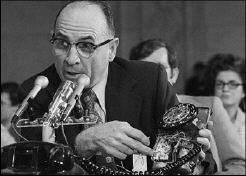
James MCCord

Senate Watergate hearings
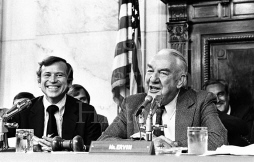 Senators James Baker and Sam
Ervin of the Watergate committee Senators James Baker and Sam
Ervin of the Watergate committee | | |
|
|
|
87.
|
When the senate hearings into
the Watergate began, there was no clear link between the break-in and the Nixon administration. What
did James McCord, one of the burglars, imply?
a. | that the president knew nothing
about the break-in and did not try to cover it up | c. | that the Nixon administration was not linked to the
break-in | b. | that Nixon should be impeached | d. | that the Nixon administration was linked to the Watergate
break-in |
|
|
|
88.
|
Who was John
Dean?
a. | one of the
plumbers | c. | a staff member for
the Irvin Watergate committee | b. | Nixon’s lawyer who testified against him in the senate
hearings | d. | an FBI agent who testified against
Nixon |
|
|
|
89.
|
In April of 1973, what did
Nixon do to clear himself in the Watergate scandal?
a. | he ordered the FBI to investigate
John Dean | c. | he fired Eliot
Richardson | b. | he fired the plumbers because they had failed to pay their union
dues | d. | he fired his top aides and appointed a new lawyer to
investigate the scandal |
|
|
|
90.
|
Who was the chairman of the
special senate committee investigating the Watergate scandal?
a. | James
McCord | c. | Senator Howard
Baker | b. | Senator Sam Ervin | d. | Senator Eliot Richardson |
|
|
|
STARTLING TESTIMONY
John
Dean was the President Nixon’s lawyer but he turned against him to save himself from
prosecution. The president quickly sent John Mitchell up to Capitol Hill to refute Dean's
charges
The hearings had suddenly reached an impasse as the committee A presidential aide
Alexander Butterfield stunned the committee when he revealed that Nixon had taped all of his
presidential conversations. Butterfield later claimed that the taping system was installed "to
help Nixon write his memoirs."
THE SATURDAY NIGHT MASSACRE
A year-long
battle for the "Nixon tapes" followed. Archibald Cox, the special prosecutor took the
president to court in October 1973 to obtain the tapes. Nixon refused and ordered Attorney General
Richardson to fire Cox. In what became known as the Saturday Night Massacre, Richardson refused the
order and resigned. The deputy attorney general also refused the order, and he was fired. Shortly
after the "massacre," the House Judiciary Committee began examining the possibility of an
impeachment hearing.
As if Nixon did not have enough troubles, just days before the
Saturday Night Massacre, Vice-President Spiro Agnew had resigned after it was revealed that he had
accepted bribes. Nixon nominated the Congressman Gerald Ford, as his new vice-president .
Congress quickly confirmed the nomination.
Federal investigators began to study Nixon's
own financial dealings . News reports revealed that Nixon had paid only $1,000 in taxes on a $200,000
income in 1971 and 1972. They did not find that Nixon did anything wrong in his taxes. Nixon
responded to the charges by saying, "People have the right to know whether or not their
president is a crook. Well, I am not a crook."
| |
|
|
|
91.
|
What did Alexander Butterfield
reveal to the senate committee?
a. | that Nixon did know about the
break-in | c. | that Nixon did not
know about the break-in | b. | that Nixon did not know about the break-in but tried to cover it
up | d. | that Nixon made tapes of all of the conversations that
went on in his office |
|
|
|
92.
|
Why were the Nixon tapes
important to the committee investigating the Watergate?
a. | they were worth a-lot of
money | c. | they showed what type of music Nixon
listened to on his I-Pod | b. | they would show if Nixon knew about the break-in and tried to cover it
up | d. | they could be used by Nixon to write a book about his
presidency |
|
|
|
93.
|
Nixon had appointed people to
investigate the Watergate scandal at the White House. When they ordered Nixon to turn over the takes
to the senate, he fired them. What was this called?
a. | the impeachment
hearings | c. | the Saturday Night
Massacre | b. | the administrative reorganization act | d. | the Washington Post
investigation |
|
|
|
94.
|
What happened to Vice President
Spiro Agnew?
a. | he had to resign because he was
taking “kick-back” money unrelated to the Watergate scandal | c. | he had to resign because he tried to pay-off the burglars
of the Watergate | b. | he had to resign because he was the one who organized the Watergate
break-in | d. | he had to resign for health
reasons |
|
|
|
95.
|
After Vice President Spiro
Agnew resigned, President Nixon had to appoint a new Vice President. Who did he
appoint?
a. | Sam
Irvin | c. | Gerald
Ford | b. | Elliot Richardson | d. | James Baker |
|
|
|
The Fall of a President
In
March 1974, a grand jury indicted Mitchell, Haldeman, Ehrlichman, and four other presidential aides
on charges of conspiracy, obstruction of justice, and perjury. Later they were convicted and sent to
prison. The investigation was closing in on the president of the United States .
NIXON
RELEASES THE TAPES
On April 30, 1974, President Nixon told a televised audience that he
was releasing 1,254 pages of edited transcripts of White House conversations about Watergate . The
president hoped that this would convince everyone of his truthfulness and leadership.Furthermore,
Nixon's offering of edited tape transcripts failed to satisfy investigators. They demanded the
unedited tapes. Nixon refused, and the case went before the Supreme Court. On July 24, 1974, the high
court ruled unanimously that the president must surrender the tapes.
THE PRESIDENT RESIGNS
Even without the original tapes, the House Judiciary Committee determined that there was
enough evidence to impeach Richard Nixon. On July 27, the committee approved three articles of
impeachment, charging the president with obstruction of justice, abuse of power, and contempt of
Congress for refusing to obey a congressional subpoena to release the tapes.
The evidence now
seemed overwhelming. On August 8, 1974, Richard M. Nixon announced his resignation from office. The
next day, Nixon and his wife, Pat, climbed into the presidential helicopter that would take them to
Andrews Air Force Base for their flight back home to California. Moments later, Gerald Ford was sworn
in as the 38th president of the United States .
THE EFFECTS OF WATERGATE
The
effects of Watergate have endured long after Nixon's resignation . In the years following
Vietnam and Watergate, the American public developed a general cynicism about many public officials.
There was a constitutional crisis because one branch of government
(the president) tried to keep the other branches of government (the Congress) from doing its job. H
also used the CIA and the FBI to obstruct (defy) the law. Nixon broke the oath he took to protect
and defend the constitution by obstructing the law. | |
|
|
|
96.
|
What happened to Nixon’s
aides?
a. | they were convicted and sent to
jail | c. | they went to trial and were found
innocent | b. | nothing | d. | they turned against Nixon |
|
|
|
97.
|
Nixon edited the tapes before
sending them to the senate. He refused to send the complete tapes. What happened
next?
a. | the senate said they were
satisfied | c. | Nixon burned the
tapes | b. | the Supreme Court ordered the president to turn over the unedited
tapes | d. | the Supreme Court said that Nixon did not have to turn
over the tapes |
|
|
|
98.
|
What did the House Judiciary
Committee do after all of this evidence came out about Nixon.
a. | they said he was guilty of
obstructing justice and recommended the House of Representatives impeach
Nixon | c. | they said he was not guilty of
obstructing justice and recommended the House of Representatives not impeach
Nixon | b. | they said they needed to investigate further | d. | they said the Senate had no business investigating
Nixon |
|
|
|
99.
|
Nixon now knew he was going to
be impeached by the House. When a group of Republican Senators told him that he would most likely be
convicted in the Senate, what did Nixon do?
a. | he fired the Republican
Senate | c. | he said he wanted to fight it
out | b. | he resigned and Ford took over as President | d. | he appointed Elliot Richardson to investigate Watergate
further |
|
|
|
100.
|
Which statement is
true?
a. | Nixon could have beaten the charges
against him. He resigned so the government could stop focusing on
Watergate | c. | Nixon created a
constitutional crisis by going against the constitution and trying to obstruct
justice | b. | Nixon did not mind resigning because he knew that Gerald Ford was going to
take over. | d. | Nothing was ever proved against
Nixon |
|
|
|
101.
|
What was the relationship
between environmentalists and industrial workers.
a. | the interests of environmentalists
and workers are not related | c. | they had conflicting interests | b. | their interests are the
same | d. | they agreed on the
issues |
|
|
|
102.
|
What is
deregulation?
a. | putting more restrictions on
industry to stop pollution | c. | removing controls from environmentalists | b. | making more regulations to protect the
environment | d. | removing or lowering regulations to
allow industries to grow |
|
|
|
103.
|
Which statement is true about
Ronald Reagan?
a. | none of these are
true | c. | he pushed for more strict
environmental regulations | b. | he advocated deregulation to improve the
economy | d. | he was in favor of air
pollution |
|
|
|
104.
|
Sometimes industrial workers
and environmentalists find themselves in conflict over issues. Large areas of forests have been put
off limits to save certain birds. That puts lumber workers out of work and effects the lumber mills
that process the lumber and all of the shops where lumbers workers shop. Whole towns are effected.
The same has been true for other industries, such as mining, chemical plants, farming, textiles and
fishing. What should the position of the government be in this conflict between jobs and the
environment?
a. | the government should ignore jobs
and protect the environment | c. | the government should stay out of the
conflict | b. | the government should ignore the environment and protect
jobs | d. | This is a problem to which there is no clear answer. The
government needs to be thoughtful and consider all sides of the
issue. |
|
|
|
Ford Travels a Rough
Road
Upon taking office, Gerald R. Ford urged Americans to put the Watergate scandal
behind them. "Our long national nightmare is over," he declared. However, the nation's
nightmarish economy persisted, and Ford's policies offered little relief.
"A FORD, NOT A LINCOLN"
Gerald
Ford seemed to many to be a likable and honest man. Upon becoming vice-president after Spiro
Agnew's resignation, Ford candidly admitted his limitations . "I'm a Ford, not a
Lincoln," he remarked. Raised in Grand Rapids, Michigan, Ford was a product of the nation's
heartland. Some people called him "square," but Ford saw nothing wrong with this. He once
remarked, "It's . . . the straight, the square that accounts for the great stability of our
nation. It's a quality to be proud of." On September 8, 1974, | 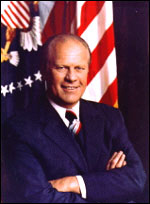
President Gerald
Ford
| | |
|
|
|
105.
|
How did Gerald Ford become
president?
a. | He was elected in
1976 | c. | Nixon resigned when he was vice
predident | b. | He was elected in 1974 | d. | Congress appointed him after Nixon
resigned |
|
|
|
106.
|
Ford became Nixon’s Vvice
President after _____ was forced to resign.
a. | Siro
Agnew | c. | Lincoln | b. | Pat Buchannan | d. | None of these |
|
|
|
107.
|
Gerald Ford gave Richard Nixon
an “full and absolute” pardon over any crimes he may have committed in Watergate. How did
the public respond to this act?
a. | the public approved of
it | c. | there were riots in some American
cities | b. | the public disapproved of it | d. | the public did not react at all |
|
|
|
108.
|
Why did Ford give Nixon a
pardon?
a. | they had a secret
deal | c. | Ford was afraid that he might be
implicated for his role in the Watergate scandle | b. | Ford wanted to get Watergate behind him so the government
could get on to more important matters | d. | Ford did not think that Nixon could be convicted if he went to court and that
would make his administration look bad |
|
|
|
109.
|
The Lincoln is the best car
that the Ford Motor Company makes. The Ford is not as good a car as a Lincoln. What did Ford mean
when he said that he was a Ford not a Lincoln?
a. | he was not as good a president as
Abraham Lincoln | c. | he liked to do
things his own way | b. | he drove a Ford not a Lincoln | d. | he could be just as good a president as
Lincoln |
|
|
|
FORD TRIES TO
"WHIP" INFLATION
By the time Ford took office, America's economy had gone
from bad to worse. Both inflation and unemployment continued to rise. After the massive OPEC
oil-price increases in 1973, gasoline and heating oil costs had soared, pushing inflation from 6
percent to I I percent by the end of 1974. In September 1974, the president invited the nation's
top economic leaders to the White House to discuss economic strategies . In the end, Ford promoted a
program of massive citizen action, called "Whip Inflation Now" or WIN. The president called
on Americans to cut back on their use of oil and gas and to take other energy-saving measures . In
the absence of incentives, though, the plan fell flat. Ford then tried to curb inflation through a
"tight money" policy. He cut government spending and encouraged the Federal Reserve Board
to restrict credit through higher interest rates . These actions triggered the worst economic
recession in 40 years | FORD BATTLES THE CONGRESS
As Ford implemented his economic programs, he continually battled a Democratic Congress
intent on pushing its own economic agenda. The Democrats called for a federal jobs program to bring
down unemployment, which had climbed to 8.5 percent in 1975. Ford rejected the plan, claiming that
pumping more money into the economy would only increase inflation. Throughout his term, Ford vetoed
bills to fund programs for health, education, and housing. During his two years as president, Ford
vetoed more than 50 pieces of legislation.
In the end, Ford's economic policies received
mixed reviews. Inflation had dropped below 10 percent by 1975 and continued to decline slowly.
Unemployment also retreated, but by 1976 it remained stuck at around 8 percent. Ford's policies,
while holding stagflation steady, seemed to offer no lasting
solutions.
| | |
|
|
|
110.
|
Inflation occurs when prices on
goods and services rise. What was a major cause of inflaltion in the mid
70’s?
a. | OPEC raised the price of oil which
raised the price of everything that used oil | c. | OPEC lowered the price of oil which raised the price of everything that used
oil | b. | the farmers started to burn crops because they wanted more money for their
products | d. | none of
these |
|
|
|
111.
|
What is
OPEC?
a. | the United Nations Economic
Councel | c. | an American
company that sets the price of oil for the United States | b. | a group of oil producing nations that join together to set
the price of oil. | d. | greedy American
oilmen |
|
|
|
112.
|
How did Ford encourage
Americans to fight inflation?
a. | cut back on consumption of oil and
gasoline | c. | stop buying houses
and consumer goods | b. | cut back on amount of food consumed | d. | maintain a positive attitude about the economy and the
country |
|
|
|
113.
|
What was the effect of
Ford’s tight money policy to curb inflation
a. | prices
increased | c. | no effect at
all | b. | the overall economy was hurt with a
recession | d. | none of
these |
|
|
|
114.
|
Why did Ford veto so many bills
passed by congress?
a. | congress was controlled by the
Republicans | c. | congress wanted to
pass laws that would put more money in the economy that would increase
inflation | b. | congress was controlled by the Democrats | d. | congress wanted to pass laws that would restrict the flow of money and
increase inflation |
|
|
|
FORD'S FOREIGN
POLICY
Ford fared slightly better in the international arena. With little experience in
diplomacy, he relied heavily on Henry Kissinger, who continued to hold the key position of secretary
of state. Following Kissinger's advice, Ford pushed ahead with Nixon's policy of
negotiation with China and the Soviet Union. In November 1974, he met with Soviet premier Leonid
Brezhnev to plan the next round of arms talks. Less than a year later, he traveled to Helsinki,
Finland, to discuss the future of East-West relations . There, some 35 nations, including the Soviet
Union, signed the so-called Helsinki _ Accords-a series of agreements that promised greater
cooperation between the nations of Eastern and Western Europe .
|
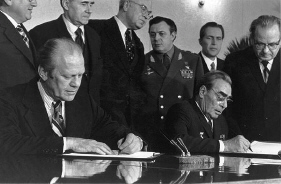 Helsinki Accords Helsinki Accords
“greater cooperation between
the nations of Eastern and Western Europe” .
| | |
|
|
|
115.
|
Which statement is
true?
a. | Ford rejected the Nixon approach to
foreign affairs and started his own programs | c. | Ford rejected the Kissinger approach to foreign
affairs | b. | Ford adopted the Reagan approach to foreign
affairs | d. | Ford continued the Nixon/Kissinger approach to foreign
affairs |
|
|
|
116.
|
What did Ford’s policies
and the signing of the Helsinki Accord do?
a. | increased tensions between the U.S.
and the Soviet Union | c. | made war between
the U.S. and the Soviets more likely | b. | had no effect on East/West relations | d. | reduced tensions betwen the communist nations and the
west |
|
|
|
The Mayaguez incident
Like
presidents before him, Ford encountered trouble in Southeast Asia. In 1975, the Communist government
of Cambodia seized the U.S. merchant ship Mayaguez in the Gulf of Siam. Ford responded with a massive
show of military force. He ordered two air strikes against Cambodia and sent a crack team of U.S .
marines to rescue 39 crew members aboard the ship. The total operation cost the lives of 41 U.S.
troops . Most Americans applauded the action as evidence of the country's strength . However,
critics argued that the mission had cost more lives than it had saved and that the president had
acted without consulting Congress
| | | |
|
|
|
117.
|
What did Gerald Ford prove to
the Nations of Southeast Asia by his actions in the Mayaguez
incident?
a. | that the U.S. victory in Vietnam had
made America strong and rsolute | c. | that the U.S. was not willing to take action to protect its
interests | b. | that the U.S. would take action to protect its interests regardless of what
happended in Vietnam | d. | that the U.S. was weak because of
the Vietnam War (Vietnam Syndrom) |
|
|
|
118.
|
The Mayaguez incident was a _____ the other nations of Southeast Asia and the world
a. | victory
for | c. | warning
to | b. | none of
these | d. | defeat for |
|
|
|
Jimmy Carter
Enters the White House
Gerald Ford won the Republican nomination for president in 1976.
However, he had to fend off a powerful conservative challenge from former California governor Ronald
Reagan . Because the Republicans seemed divided over Ford's leadership, and because Ford's
economic policies had failed to provide substantial relief, the Democrats confidently eyed the White
House. "We could run an aardvark this year and win," predicted one Democratic leader. The
Democratic nominee was indeed a surprise: a nationally unknown peanut farmer and former governor of
Georgia, Jimmy Carter.
THE ELECTION OF 1976
During the post-Watergate era-in
which cynicism toward the Washington establishment ran high-an outsider such as Jimmy Carter proved
to be the right candidate for the time. The soft-spoken man from Plains, Georgia, promised to restore
integrity to the nation's highest office . "I will never tell a lie to the American
people," he said with a distinctive Southern drawl. Throughout the presidential campaign, Carter
and Ford squared off over the key issues of inflation, energy, and unemployment. However, Carter
gained fewer points for his knowledge of economic issues than for his personality and sense of
morality. He openly declared himself a born-again Christian, and he took pride in his pro-civil
rights stance . In addition, Carter had a warm, direct campaign style. He would walk up to a stranger
on the street, smile, and stick out his hand. "Hello, I'm Jimmy Carter and I'm running
for president," he'd say. "I'd like your vote ." | 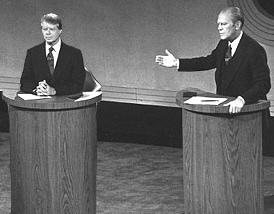 The Carter - Ford Debate in
1976 The Carter - Ford Debate in
1976
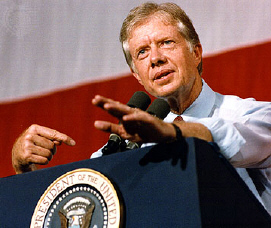
President Jimmy Carter
Ford began the 1976 campaign well behind Carter in the
polls. Although he narrowed the gap by election day, he could not close it. Jimmy Carter won a close
election, claiming 40.8 million popular votes to Ford's 39.1 million. | | |
|
|
|
119.
|
In the 1976 election there was
a split in the Republican party between the supporters of President Ford and the supporters of _____
a. | Jimmy
Carter | c. | Ronald
Reagan | b. | George Bush | d. | Richard Nixon |
|
|
|
120.
|
Why did the people of the
United States like Jimmy Carter in 76?
a. | he was a simple, honest man from
outside the Washington political scene | d. | all of these | b. | people were tired of the corruption inside
Washington | e. | none of
these | c. | people did not look at Carter as a
politician |
|
|
|
GEORGIA COMES TO WASHINGTON
From the very beginning, the new first family brought a down-to-earth style to Washington
. Refusing the traditional limousine ride after his inauguration, Carter walked with his wife,
Rosalynn, and daughter, Amy, down Pennsylvania Avenue to the White House. After settling into office,
Carter stayed in touch with the people by holding Roosevelt-like "fireside chats" on radio
and television . He also held "phone-ins" so that people could talk directly with their
president.
However, Carter failed to reach out to Congress in a similar way. Because he
had run as an outsider, Carter refused to play the "insider" game of compromise and deal
making . Relying mainly on a team of advisers from Georgia, Carter even alienated himself from
congressional members of his own party. Democrats on Capitol Hill often joined Republicans to sink
the president's budget proposals, as well as his ambitious legislative agenda, which included
major reforms of tax and welfare systems.
| 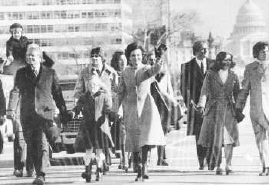
Carter and Family walk to the White
House
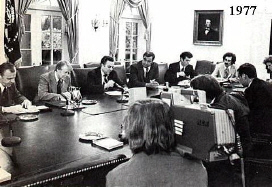 Carter White House
Staff Carter White House
Staff | | |
|
|
|
121.
|
Jimmy Carter tried to portray
himself as
a. | a simple man of the
people | d. | a New England Liberal
Elite | b. | an imperial president | e. | a Southern Liberal Elite | c. | a sophisticated
intellectual |
|
|
|
122.
|
Which statement is true about
the Carter administration.
a. | they did not build good relations
with congress so they had trouble getting their laws passed | c. | the team Carter brought with him from Georgia were good at
getting things done in Washington | b. | they built good relations but could not get their laws passed because he was a
southerner | d. | none of these are
true |
|
|
|
Carter's Domestic
Agenda
Like Gerald Ford, President Carter focused much of his attention domestically on
battling the country's energy and economic crises . While he met with some successes, Carter
could not bring the United States out of its economic downswing.
CONFRONTING THE ENERGY
CRISIS
Carter considered the energy crisis to be the single most important issue facing
the nation . A large part of the problem, the president believed, was America's over reliance on
imported oil. On April 18, 1977, Carter sat before the nation and in a fireside chat urged his
fellow Americans to cut their consumption of oil and gas Carter asked Americans to turn down their
thermostats to 65 degrees in the day and 55 degrees at night. He proposed a cabinet-level Department
of Energy and presented Congress with more than 100 proposals on energy conservation and development.
The battle over the president's energy policy started almost immediately. Representatives from
oil- and gas-producing states fiercely resisted some of the proposals. Automobile manufacturers also
lobbied against gas-rationing provisions. "It was impossible for me to imagine the bloody
legislative battles we would have to win,- Carter later wrote.
Out of the battle came the
National Energy Act The act placed a tax on gas-guzzling cars, removed price controls on oil
and natural gas, produced in the United States,
|
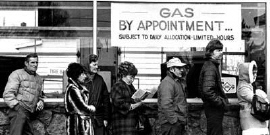
People line up to make an appointment to buy
gas
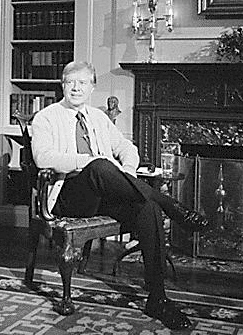
President Carter talks to the nation about the
energy crisis
| | and extended tax
credits for the development of alternative energy supplies. By 1979, U.S . dependence on foreign oil
had eased slightly. Private industry did its part by developing more gas-efficient automobiles and
home heating systems. In addition, American citizens helped by lowering their thermostats and
reinsulating their homes. A few also took advantage of a tax credit to install solar-heating panels
| | |
|
|
|
123.
|
Which statement is
true?
a. | Carter used the fireside chat to
urge Americans to cut their consumption of energy as a way of fighting the energy
crisis | d. | all of these statements are
true | b. | Carter urged individual Americans to take part in the conservation of energy
by doing things like; lowering heat in their homes and turning off
lights | e. | none of these statements are
true | c. | Carter believed that a central energy problem was America’s
over-dependance on foreigh oil |
|
|
|
124.
|
Which item below did the
National Energy Act not
do?
a. | Put a tax on large cars that
consumed lots of gasoline. If people bought fewer large cars they would consume less
gas | c. | Removed controls on the price of
American oil and gas so the price could rise. If gas and oil cost more, Americans would consume
less. | b. | Encouraged Americans to travel more in the U.S. so they would use more
American gasoline and less foreign gasoline |
|
|
|
THE ECONOMIC CRISIS WORSENS
Unfortunately, these
energy saving measures could do little to combat a sudden new economic crisis . In the summer of
1979, renewed violence in the Middle East produced a second major fuel shortage in the United States
. To make matters worse, OPEC announced another major price hike. In 1979 inflation soared from 7.6
percent to 11 .3 percent.
Faced with increasing pressure to act, Carter attempted an array of
measures. He implemented voluntary wage and price freezes to slow inflation. He also tried to reduce
the national debt through spending cuts. To stimulate business, Carter deregulated, or lifted
government controls from, trucking, railroad, and shipping industries . To reduce the money supply,
he convinced the Federal Reserve to raise interest rates. None of these measures worked. Worse yet,
Carter's scattershot approach convinced many people that he had no economic policy at all.
Carter fueled this feeling of uncertainty by delivering his now famous "malaise" speech, in
which he complained of a "crisis of confidence" that had struck "at the very heart and
soul of our national will ."
Carter's address made many Americans feel that their
president had given up. By 1980, inflation had climbed to nearly 14 percent, the highest rate since
1947. The standard of living in the United States slipped from first place to fifth place in the
world. Carter's popularity slipped along with it . Polls put his approval rating at a dismal 26
percent, lower than Richard Nixon's lowest figures. The fact that this economic downswing-and
Carter's inability to solve it-visited the nation during an election year was one of the key
factors in sending Ronald Reagan to the White House.
|
|
|
125.
|
Why would a crisis in the
Middle East provoke a feul shortage in the United States?
a. | The U.S. needed oil to prepare for a
possible war with the Soviet Union | c. | The U.S. got much of its oil from the middle
east | b. | A crisis in the middle east could not provoke fuel shorages in the
U.S. | d. | The U.S. had to supply a great deal of oil to
Israel |
|
|
|
126.
|
Inflation is a rise in prices
that hurt everyone in the economy. Most of the actions that Carter took were designed to ______ so
prices would fall.
a. | reduce the amount of money in
circulation | c. | increase wages and
prices | b. | increase the amount of money in circulation | d. | increase unemployment |
|
|
|
127.
|
Which statement is
true?
a. | Under Jimmy Carter the economy of
the United States improved | c. | Under Jimmy Carty the economy of the United States declined and the standard
of living declined also | b. | Under Jimmy Carter the economy of the United States declined but the standard
of living rose | d. | President Carter had a strong
economic plan that improved the American economy |
|
|
|
128.
|
President Carter had to face
Ronald Reagan in the 1980 election. The economy _____ President Carter’s chances of
victory.
a. | helped | c. | had no effect on | b. | hurt |
|
|
|
A CHANGING ECONOMY
Many of the economic
problems Jimmy Carter struggled with resulted from long-term trends in the economy. Since the 1950s,
the rise of automation and foreign competition had reduced the number of manufacturing jobs. At the
same time, the service sector of the economy expanded rapidly. This sector includes industries such
as communications, transportation, and retail trade. During the 1970s, the shift toward a
service-based economy accelerated, spurred on by the development of the tiny microchip that enabled
computers to be cheaply mass-produced.The rise of the service sector and the decline of manufacturing
jobs meant big changes for some American workers. Workers left out of the shrinking pool of
manufacturing jobs faced an increasingly complex job market. Many of the higher-paying service jobs
required more education or specialized skills than did manufacturing jobs. The lower-skilled service
jobs usually did not pay well.
Growing overseas competition during the 1970s caused
further change in America's economy. The booming economies of West Germany and countries on the
Pacific Rim (such as Japan, Taiwan, and Korea) cut into many U.S. markets. Many of the nation's
primary industries-iron and steel, rubber, clothing, automobiles- had to cut back production, lay off
workers, and even close plants .
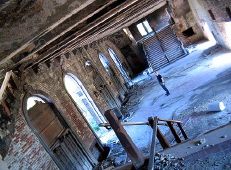 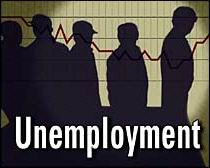
|
|
|
129.
|
A manufacturing economy is
based on manufacturing products like steel, clothing and electronics. A service economy is based on
providing services such as computer information processing, and telecommunications. In the
1970’s the U.S. began to shift from a _____ economy to a _____ economy
a. | service -
manufacturing | c. | manufacturing -
service | b. | service - computer | d. | none of these |
|
|
|
130.
|
As thosands of industries shut
down and manufacturing plants closed, a wide area of the northeast United States became known as
the
a. | frost
belt | c. | farm
belt | b. | rust belt | d. | silicon valley |
|
|
|
131.
|
The old manufacturing jobs of
the northeast and central United States were usually high paying union jobs. Also, energy costs were
high in this area because energy plants also hired union workers. What happened to these jobs in the
70’s
a. | most jobs were saved because of the
use of technology and computers | c. | union jobs were lost as factories moved south, west and to foreign countries
where they did not have to pay union wages | b. | all of these are true | d. | most were saved as factories put in place better
machinery |
|
|
|
132.
|
The higher paying service jobs
of the new economy required
a. | lower skills than the average
industrial worker. | c. | no more education
and trainging than the average industrial worker had | b. | the same skills as lower service industries such as clerk
and restaurant worker | d. | more education and trainging than
the average industrial worker had |
|
|
|
133.
|
The rise in unemployment, the
loss of manufacturing jobs and the loss of industries to foreign countries
a. | hurt people who lived in the cities
especially hard | c. | did not effect
minorities | b. | did not effect people who lived in the
cities | d. | had little effect on the people of the
northeast |
|
|
|
CARTER AND CIVIL
RIGHTS
Carter took special
pride in his civil rights record . His administration included more African Americans and women than
any before .
In 1977, the president appointed civil rights leader Andrew Young as U.S . ambassador
to the United Nations. Young was the first African American to hold that post. To the judicial branch
alone, Carter appointed 28 African Americans, 29 women (including 6 African Americans), and 14
Latinos. However, President Carter fell short of what many civil rights groups had expected in terms
of legislation. Critics claimed that Carter-preoccupied with battles over energy and the
economy-failed to give civil rights his full attention. Meanwhile, the courts began to turn against
affirmative action . In 1978, the Supreme Court decided, in the case of Regents of the University of
California v Bakke, that the affirmative action policies of the university's medical
school were unconstitutional and discriminated against some students . The decision made it more
difficult for organizations to establish effective affirmative action programs. |
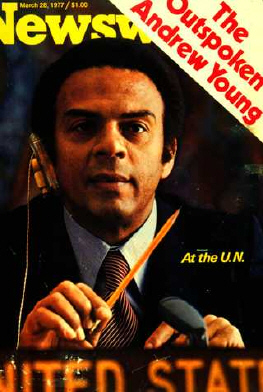
Andrew Young | Jimmy Carter gave a great deal
of thought to human rights around the world. In fact, he based much of his foreign policy on human
rights. Carter rejected the philosophy of realpolitik, the pragmatic policy of negotiating with
powerful nations despite their behavior. Instead, the president strived for a foreign policy
committed to human rights
| | |
|
|
|
134.
|
President Carter appointed more
minorities than any other president to that time but many civil rights leaders criticized him
because
a. | he did not appoint enough minorities
to high profile jobs | c. | he was, in his
heart, a southerner | b. | he did not give enough attention to civil
rights | d. | he was to
religious |
|
|
|
135.
|
What kept Carter from doing all
that he could have done regarding rights for minorities?
a. | he was afraid of white
backlash | c. | he had too many
southern whites in his administration | b. | he was busy with the economy and energy | d. | he was afraid of congress |
|
|
|
136.
|
In the 1970’s a medical
student named, Bakke, filed a law suite against the University of California. He claimed that
minority affirmative action students were given preferred treatment over him and got admitted to the
medical school even though there qualifications were less than his. How did the Supreme Court rule in
the Bakke v University of California case
a. | they disagreed with Backke and took
the side of the University of California | c. | they did not decide on the case. | b. | they said that Bakke’s case was groundless an upheld
affirmative action | d. | they agreed with Bakke and said that
race could not be the single reason for admitting students to medical
school |
|
|
|
137.
|
Nixon and Kissinger advocated a
foreign policy based on realpolitik. They said that the U.S. should do
what is practical to promote world peach, even if it meant supporting dictatorships around the world.
How did Carter feel about the realpolitik approach?
a. | he supported
it | c. | he rejected
it | b. | he ignored
it | d. | he incorporated it into his own foreign
policy |
|
|
|
ADVANCING
HUMAN RIGHTS
Jimmy Carter, like Woodrow Wilson, sought to use moral principles as a guide
for U.S. foreign policy. He believed that the United States needed to commit itself to promoting
human rights-such as the freedoms and liberties listed in the Declaration of Independence and the
Bill of Rights-throughout the world.
Putting his principles into practice, President Carter
cut off military aid to Argentina and Brazil, countries that had good relations with the United
States but had imprisoned or tortured thousands of their own citizens . Carter followed lowed up this
action by establishing a Bureau of Human Rights in the State Department. "Human rights had
become the central theme of our foreign policy in the minds of the press and public," Carter
recalled. "It seemed that a spark had been ignited, and I had no inclination to douse the
growing flames ." But as time went on, that flame cooled . Although many people favored
Carter's idealism, supporters of the containment policy felt that the president's policy
undercut allies such as Nicaragua, a dictatorial but |
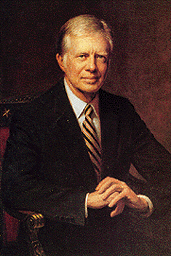
President Jimmy Carter
anti-Communist country and the Shah of Iran..
Others argued that by supporting dictators in South Korea and the Philippines, Carter was acting
inconsistently. In 1977, Carter's policies drew further criticism when his administration
announced that it planned to give up ownership of the Panama Canal. | | |
|
|
|
138.
|
Carter’s foreign policy
was
a. | practical and based on human
rights | c. | supported by dictators around the
world | b. | undemocratic | d. | ideologically based on human
rights |
|
|
|
139.
|
Carters ideological approach to
foreign policy based on human rights,
a. | made America’s allies
stronger | c. | left many American
allies open to attacks by their enemies | b. | none of these | d. | was accepted by Americas allies |
|
|
|
140.
|
Who decided to give up control
of the Panama Canal to the government of Panama?
a. | the Supreme
Court | c. | The State
Department | b. | the House of Representatives | d. | President Carter |
|
|
|
141.
|
Carter tried to apply the Bill
of Rights and the ideas of the Declaration to
a. | the communist
countries | c. | the entire
world | b. | allies of the United States | d. | European countries |
|
|
|
YIELDING THE PANAMA CANAL
Since 1914, when the United States obtained full ownership of the Panama Canal,
Panamanians had resented having their nation split in half by a foreign power. Shortly after 1964,
President Lyndon Johnson began negotiations with the Panamanians to help ease tensions . Negotiations
continued off and on into the Carter administration .
In 1977, the nations finally agreed to
two treaties, one of which promised to turn over control of the Panama Canal to Panama on December
31, 1999. In 1978, the U.S. Senate, which had to ratify each treaty, approved both treaties by a vote
of 68 to 32-one more vote than the required two-thirds. Public opinion also was divided. According to
a Gallup poll, 45 percent of Americans favored the pacts, while 42 percent opposed them. Despite
their cool reception by the American public, the treaties did bring about a warmer relationship
between the United States and Latin America.
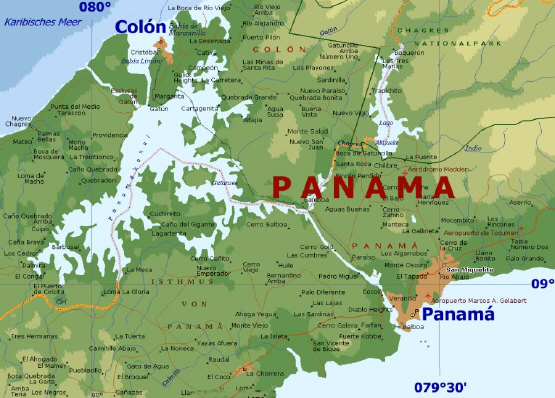 | |
|
|
|
142.
|
Turning over control of the
Panama Canal resulted in
a. | conflict between Panama and the
U.S. | c. | better relations between the U.S.
and Latin America | b. | conflict between the nations of Latin America and the
U.S. | d. | had no effect on America’s relations with other
countries |
|
|
|
143.
|
Negotiations over control of
the Panama Canal started in the _____ administration
a. | Carter | c. | Ford | b. | Kennedy | d. | Johnson |
|
|
|
144.
|
The Panama Canal is in
a. | Columbia | c. | Colon | b. | Nicaragua | d. | Panama |
|
|
|
THE
COLLAPSE OF DETENTE
When Jimmy Carter took office, detente-the relaxation of tensions
between the world's superpowers- had reached a high point. Beginning with President Nixon and
continuing with President Ford, U.S. officials had worked to ease relations with the Communist
superpowers of China and the Soviet Union. However, Carter's firm insistence on human rights led
to a breakdown in relations with the Soviet Union. President Carter's dismay over the Soviet
Union's treatment of dissidents, or opponents of the govern governments policies, delayed a
second round of SALT negotiations .
President Carter and Soviet premier Leonid Brezhnev
finally met in June of 1979 in Vienna, Austria, where they signed an agreement known as SALT II.
Although the agreement did not reduce armaments, it did provide for limits on the number of strategic
weapons and nuclear-missile launchers that each side could produce. |
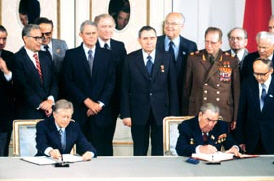
The SALT II agreement,
however, met sharp opposition in the Senate . Critics argued that it would put the United States at a
military disadvantage . Then, in December 1979, the Soviets invaded the neighboring country of
Afghanistan. When President Carter heard of the invasion, he activated the seldom-used White
House-Kremlin hot line and protested to Brezhnev that the action was a "gross interference in
the internal affairs of Afghanistan ." As a result of the invasion, Carter refused to
fight for the SALTII agreement, and the treaty died | | |
|
|
|
145.
|
The overall effect of
Carter’s ideological foreign policy was to
a. | reduce tension between the U.S. and
Soviet Union | c. | make world peace
more likely | b. | increase tension between the worlds super powers (U.S. and Soviet
Union) | d. | increase the military power of the
U.S. |
|
|
|
146.
|
Which branch of government is
required to approve treaties made by the president. It is called, “advise and
consent.”
a. | the
Senate | c. | the Supreme
Court | b. | the House of Representatives | d. | the State Department |
|
|
|
Triumph and Crisis in the Middle
East
Through long gasoline lines and
high energy costs, Americans became all too aware of the troubles in the Middle East. In that area of
ethnic, religious, and economic conflict, Jimmy Carter achieved one of his greatest diplomatic
triumphs- and suffered his most tragic defeat.
THE CAMP DAVID ACCORDS

Jimmy Carter
enjoyed a shining moment in a historic handshake between two long-time enemies-Egyptian president
Anwar el-Sadat and Israeli prime minister Menachem Begin. Through negotiation and arm-twisting,
Carter helped forge a peace between the two nations that marked the first major break in Middle
Eastern hostilities since the creation of Israel in 1948. | In 1974, Henry
Kissinger's shuttle diplomacy had helped end the Yom Kippur War between Egypt and Israel. At
that time, Sadat and Begin had begun discussing an overall peace between the two nations . In the
summer of 1978, Carter seized on the peace initiative. When the peace talks stalled, Carter invited
Sadat and Begin to Camp David, the presidential retreat in Maryland.
After 13 days of intense
negotiations, the three leaders reached two agreements known as the Camp David Accords. The first
agreement provided for a five-year transition period during which Israel and Jordan would work out
the issue of self-rule for the Palestinians, Arabs living on the West Bank and Gaza Strip-areas
captured by Israel during earlier wars. The second agreement was aimed specifically at end- ending
hostilities between Israel and Egypt. During a White House ceremony in March of 1979, Sadat and Begin
signed a detailed peace treaty based on the accords . Under the treaty, Israel agreed to withdraw
from the Sinai Peninsula, which it had seized from Egypt during the Six-Day War in 1967. In exchange,
Egypt became the first Arab nation to recognize Israel's existence as a nation.
The treaty left many issues unresolved. For example, the document said little about the
independence claims of Palestinians . | | |
|
|
|
147.
|
The Camp David Accords was a
historic moment and achievement for President Carter. Who laid the groundwork for these
accords?
a. | Henry Kissinger and
Nixon | c. | John F.
Kennedy | b. | President Johnson | d. | Golda Meir |
|
|
|
148.
|
What two nations did Carter
bring together at Camp David to sign the accords?
a. | Egypt and
Jordan | c. | Jordan and
Syria | b. | Egypt and Israel | d. | Iran and Israel |
|
|
|
149.
|
Israel became a nation in 1948.
Since that time no Arab nation had recognized Israel’s right to be a nation in the world. What
historic event happened at Camp David related to this?
a. | Egypt became the first Arab nation
to recognize Israel’s right to be a country | c. | Saudi Arabia became the first Arab nation to recognize Israel’s right to
exist | b. | Israel was recognized by the entire Arab
world | d. | nothing historic happened at Camp
David |
|
|
|
150.
|
Which statement is
true
a. | Carter helped a little with the
negotiations at Camp David but Israel and Egypt would have agreed even without
him | c. | Anwar Sadat and Menachem Began were
really plotting to double cross each other | b. | It was President Carter’s negotiating skills and
persistence that made the agreement between Egypt and Israel
possible | d. | none of these statements are
true |
|
|
|
151.
|
The Camp David Accords were
signed in
|
|
|
152.
|
At the Camp David meeting,
President Anwar Sadat represented ______ and Prime Minister Menachem Began represented
______
a. | Israel -
Egypt | c. | Egypt -
Israel | b. | Egypt - the U.S, State Department | d. | Jordan - Israel |
|
|
|
THE IRAN HOSTAGE
CRISIS
Since the 1950s, the United States had provided political and military assistance
to the government of the shah of Iran. He was a loyal ally of the U.S. in the cold war. By 1979,
however, the shah's regime was in deep trouble. The shah's enemies claimed that the
secret police, for example, tortured thousands of prisoners and executed many others without trial.
But the real objection to the shah was the fact that he was too western for the Muslim extremists and
wanted Iran to be a state based on the western model. In January 1979, revolution broke out . The
Muslim religious leader Ayatollah Ruhollah Khomeini led the rebels in overthrowing the shah and
establishing a religious state based on strict obedience to the Qur'an.Carter failed to support
the shah but in October of 1979, the president allowed the shah to temporarily enter the United
States for cancer treatment.
The act infuriated the revolutionaries of Iran. On November 4,
1979, armed students seized the U.S . embassy in Tehran and took 52 Americans hostage. The militants
demanded that the United States send the shah back to Iran in return for the release of the hostages
Carter forced the dying shah to leave the United States and Egypt accepted him.
A year-long
standoff followed . The president banned all trade with Iran and eventually severed diplomatic
relations with the nation. because the terrorists would not release the American hostages. Carter
tried quiet negations and those efforts finally paid off in late 1980. The hostages were released on
January 20, 1981, shortly after the new president, Ronald Reagan, took the oath of
office.
Carters ideological “human rights” foreign policy was partly responsible
for the fall of the shah of Iran. and the takeover by Muslim extremists. Iran continues to be a
supporter of Muslim terrorism even to this day. |
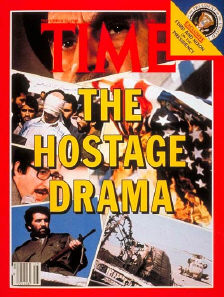
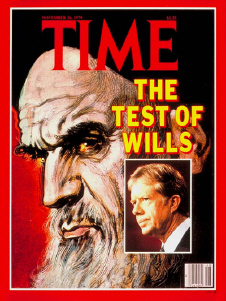 | | |
|
|
|
153.
|
Which statement is
true
a. | The shah of Iran wanted his nation
to be more western, like the nations of Europe | d. | The shah of Iran, sick with cancer, was forced to leave the United States by
Jimmy Carter | b. | The shah of Iran was a strong ally of the United States in the cold
war | e. | all of these statements are
true | c. | The shah of Iran was hated by the Muslim
extremists |
|
|
|
154.
|
In Iran, the enemies of the
Shah were
a. | moderate democratic
forces | c. | foreign agents of the CIA and
KGB | b. | economic conservatives in the business
community | d. | Muslim
extremists |
|
|
|
155.
|
How long were the workers at
the American embassy in Iran held hostage by the Muslim terrorists?
a. | three
years | c. | two
years | b. | one year | d. | six months |
|
|
|
156.
|
The Shah of Iran had been an
strong ally of the United States for many years. How did the Carter administration deal with the Shah
when he asked to take up residence in the U.S. for cancer treatment?
a. | he was allowed to stay in the U.S.
as resident alien for as long as he wanted | c. | he decided he did not want to come to the
U.S. | b. | he was allowed to come to the U.S. for a brief period of time but was then
forced to leave without his cancer treatment | d. | he was told he could stay for his treatments for a year but then had to
leave |
|
|
|
157.
|
What kind of government was
set-up in Iran after the Shah was forced to leave?
a. | a
democracy | c. | a communist
dictatorship | b. | a democracy with a king | d. | a Muslim religious dictatorship |
|
|
|
158.
|
Which statement is
true
a. | After the fall of the Shah, Iran
became a major supporter of Islamic terrorism and continues to support terrorists around the world to
this day | c. | Iran is a major
ally of the United States in the international war on terrorism | b. | After a short time where Iran became a religious state, a
new government was elected and Iran became a positive force for peace in the
world | d. | none of these statements are
true |
|
|
|
The Roots of
Environmentalism
Although
many Americans began mobilizing in the 1970s to protect the environment, the realization that urban
growth and industrial development were damaging the nation's natural resources had actually
begun a decade earlier. In particular, a shocking book had awakened America's concerns about the
environment and helped lay the groundwork for the activism of the 1970s.
|
|
|
159.
|
What two thing made Americans
wake up to the fact that the environment was being damaged?
a. | growth of highways and oil
pollution | c. | asbestos and lung
cancer | b. | shrinking cities and new factories | d. | growth of cities and
industrialization |
|
|
|
RACHEL CARSON AND SILENT
SPRING
In 1962, Rachel
Carson, a marine biologist, published a book entitled Silent Spring . In it, she attacked the growing
use of pesticides-chemicals used to kill insects and rodents. Many owners of large farms sprayed a
variety of pesticides on their crops to keep hungry insects from devouring their harvest. Carson
argued that pesticides poisoned the very food they were intended to protect and as a result killed
many birds and fish.
In her book, Carson warned that America faced a "silent
spring," in which birds killed off by pesticides would no longer fill the air with song.
"It was a spring without voices," she wrote. "On the mornings that had once throbbed
with the dawn chorus of robins, catbirds, doves, jays, wrens and scores of other bird voices there
was now no sound; only silence lay over the fields and woods and marsh." Carson argued that one
pesticide in particular, DDT, was a threat even to humans. She contended that DDT, which is very slow
to decay, made its way through the entire food chain-from plants to animals and ultimately to human
beings.
Within six months of its publication, Silent Spring sold nearly half a million copies
. It also prompted an immediate counterattack from many chemical companies, which attacked the book
as inaccurate and threat ended legal action against Carson. However, for a majority of Americans,
Carson's book was an awakening to the danger that human activity posed to the natural
environment. "There's no doubt about the impact of Silent Spring, its a real shocker,"
declared a reviewer of the book. People throughout the country wrote to their representatives in
Congress and to the president, demanding an investigation into the nation's pesticide use.
Shortly after the book's publication, President Kennedy established an advisory committee to
investigate the situation
With Rachel Carson's prodding, the nation slowly began to focus
more on environmental issues . In 1963, Congress passed the Clean Air Act, which regulated
automotive and industrial emissions. Although Carson would not live to see the U.S. government outlaw
DDT in 1972, her work helped many Americans realize that their everyday behavior, as well as the
nation's industrial growth, had a damaging effect on the environment .
|
|
|
160.
|
The book, “Silent
Spring,” warned people about the use of
a. | chemicals to kill insects and
rodents | c. | chemicals used to
kill birds | b. | accidental oil spills | d. | noise pollution |
|
|
|
161.
|
Who was the author who wrote,
Silent
Spring?
a. | John
Kennedy | c. | Ralph
Nader | b. | Rachel Carson | d. | none of these |
|
|
|
162.
|
According to the author, the
main source of pollution was
a. | foreign
countries | c. | farms | b. | industrial factories | d. | cities |
|
|
|
163.
|
In 1963 what law did Congress
pass to help clean up the environment?
a. | Clean Air
Act | c. | Water pollution
Act | b. | Clean Cities Act | d. | American Waterways Act |
|
|
|
164.
|
What dangerous chemical did the
government outlaw in 1972?
a. | Asbestos | c. | Carbon Monoxide | b. | Carbon Dioxide | d. | DDT |
|
|
|
165.
|
What was the thesis of the
book, Silent
Spring?
a. | the noise from hip hop music is
driving away the birds | c. | pollution might
get into the food chain and kill all the birds someday | b. | noise pollution can drive the birds out of the
community | d. | birds could loose the ability to
sing because of pollution |
|
|
|
Environmental Concerns in
the 1970s
Throughout the
1970s, the administrations of Richard Nixon and Jimmy Carter, along with numerous grassroots
organizations, confronted such environmental issues as pollution, conservation, and the growth of
nuclear energy.
THE FIRST
EARTH DAY
The United States ushered in the 1970s-a decade in which it would actively
address its environmental issues-fittingly enough with the first Earth Day celebration . In late
1969, Wisconsin's - - Senator Gaylord Nelson had suggested that Americans set aside April 22,
1970, as a day of serious discussion of environmental problems. On that day, nearly every community
in the nation and more than 10,000 schools and 2,000 colleges hosted some type of
environmental-awareness activity. The organizers of the first Earth Day, many of whom were antiwar
and civil rights activists, spotlighted such problems as pollution, the growth of toxic waste, and
the earth's dwindling resources.
|
|
|
166.
|
What was the purpose of Earth
Day?
a. | to give old hippies from the 60s
something to do | c. | promote
environmental awareness | b. | promote a return to the good life of living in rural
areas | d. | promote the use of insecticides to kill animals that
pollute the earth |
|
|
|
THE GOVERNMENT TAKES
ACTION
President Nixon was not considered an environmentalist, or
someone who takes an active role in advocating measures to protect the environment. However, Nixon
recognized the nation's growing concern about the environment. In his 1970 State of the Union
address he declared, "The great question of the seventies is : Shall we surrender to our
surroundings or shall we make our peace with nature and begin to make reparations for the damage we
have done to our air, to our land and to our water?"
President Nixon set out on a course
that led to the passage of several landmark measures to protect the environment. In 1970, he
consolidated 15 existing federal pollution programs into the Environmental Protection Agency (EPA) .
The new agency was given the power to set and enforce pollution standards, to conduct environmental
research, and to assist state and local governments in pollution control. Today, the EPA remains the
federal government's main instrument for dealing with environmental issues .
Nixon also
signed a new Clean Air Act in 1970. The act gave the nation's industries five years to meet new
pollution standards, including a mandate that automakers reduce the tailpipe emissions of their new
cars by 90 percent. When automakers complained that they would be unable to meet this goal by 1975,
the EPA extended the deadline to the 1980s. Automakers eventually complied by introducing the
catalytic converter (which changes tailpipe pollutants into less harmful substances). The use of
catalytic converters (smog devices) also forced consumers to use gasoline free of additives
containing lead, a harmful
pollutant.
Following the 1970 Clean Air Act, Congress passed laws that limited pesticide use,
protected endangered species, and curbed strip mining-the practice of mining for ore and coal by
digging gaping holes in the land. While it made significant advances in environmental protection, the
Nixon administration failed to fully satisfy either the conservative or the liberal element of
society. Conservatives complained that the new environmental laws placed too great a burden on
business, and liberals contended that the new legislation did not go far enough.
|
|
|
167.
|
Which statement is
true?
a. | Richard Nixon did very little to
help the environment | c. | Richard Nixon
worked to block laws that helped the environment | b. | Richard Nixon took an active role in trying to protect the
environment | d. | none of these are
true |
|
|
|
168.
|
Which statement is
true?
a. | the conservatives were critical of
Nixon over his environmental policies | c. | the liberals and conservatives were critical of Nixon over his environmental
policies | b. | the liberals were critical of Nixon over his environmental
policies | d. | neither the liberals nor the
conservatives criticized Nixon over his environmental
policies |
|
|
|
169.
|
What agency did Richard Nixon
create to coordinate the clean-up of the environment?
a. | Food and Drug Administration
FDA | c. | pollution Tax Agency
PTA | b. | Environmental Protection Agency EPA | d. | Department of Education DE |
|
|
|
170.
|
What is one result of the Clean
Air Act?
a. | trucks from Mexico cannot use
American highways | c. | a percentage of
Japanese cars have to be manufactured in the United States | b. | a new interstate highway system was built in the United
States | d. | automobiles have to pass smog
inspections |
|
|
|
171.
|
Why did people stop using
gasoline that contained lead?
a. | leaded gasoline is too
heavy | c. | smog devices don’t work well
with leaded gasoline | b. | none of these are reasons | d. | leaded gasoline costs too much |
|
|
|
BALANCING PROGRESS AND
CONSERVATION IN ALASKA
During the 1970s, the federal government took steps to ensure the
continued well-being of the nation's largest, and one of its most ecologically sensitive,
states. In 1968, the Atlantic Richfield Company announced the discovery of a gigantic oil field along
Alaska's Arctic coast. In 1974, construction began on a pipeline to carry the oil 800 miles to
the ice-free ports of the state's southern coast. The discovery of oil and the subsequent
construction of a massive system to transport it created many new jobs and greatly increased state
revenues.
However, the influx of new development also raised concerns about Alaska's
wildlife environment, as well as the rights of its native peoples. In 1971, Nixon signed the Alaska
Native Claims Settlement Act, which turned over millions of acres of land to the state's native
tribes for conservation and tribal purposes. In 1978, President Carter enhanced this conservation
effort by setting aside an additional 56 million acres in Alaska as national monuments. In 1980,
Congress added another 104 million acres to the state's protected conservation
areas
|
|
|
172.
|
Why was the Alaska pipeline
built?
a. | to move oil to ports in the Southern
part of the state where ships could transport it | c. | to move gasoline from the refineries to the
cities | b. | to move oil to the big cities of Alaska and northern American
cities | d. | to move oil from the ships to the oil
fields |
|
|
|
173.
|
What was the main concern over
the Alaska oil pipeline?
a. | concern over the Alaska
wildlife | c. | Alaska might run
out of oil and be broke | b. | concern over pollution of Alaska farm lands | d. | business might be taken away from the ships that traditionally transported
oil |
|
|
|
174.
|
What steps did Nixon take to
protect Alaska from oil pollution
a. | turned over land to the Alaskan
Indians | c. | both of
these | b. | designated large areas of Alaska as preserves for wild
life | d. | neither of
these |
|
|
|
THE DEBATE OVER NUCLEAR
ENERGY
As the 1970s came
to a close, Americans became acutely aware of the dangers that nuclear power plants posed to both
humans and the environment. Since the 1950s, nuclear power advocates had argued that nuclear energy
was the energy of the future. It was cheap, plentiful, and, they argued, environmentally safe. They
pointed to years of safe operation at nuclear plants and called for larger and more powerful plants
to meet the nation's growing energy needs. During the 1970s, as America realized the drawbacks
to its heavy dependence on foreign oil for energy, nuclear power seemed an attractive
alternative
However, opponents of nuclear energy warned against the industry's
growth. They contended that nuclear plants, and the wastes they produced, were potentially dangerous
to humans and their environment. The construction of more nuclear power plants, they argued,
increased the likelihood of accidents, which could lead to the accidental release of deadly radiation
into the air.
|
|
|
175.
|
What made nuclear energy look
so good to some Americans in the 1970s?
a. | it was
cool | c. | it was an easy way to produce
oil | b. | it looked like it might be a clean source of energy to replace
oil | d. | it was a clean way to produce
oil |
|
|
|
176.
|
What did opponents of nuclear
energy argue?
a. | accidents at plants could cause oil
spills | c. | accidents at plants could cause
pollution dangerous to humans | b. | it would hurt the economies of oil producing
countries | d. | it was too
expensive |
|
|
|
177.
|
What government agency
monitors the nuclear power industry?
a. | The Environmental Protection
Agency | c. | The Atomic Energy
Commission | b. | The Nuclear Regulatory Commission | d. | The Manhattan Project |
|
|
|
THREE MILE
ISLAND
In the early hours
of March 28, 1979, the concerns of nuclear energy opponents appeared to come true. That morning, one
of the nuclear reactors at a plant on Three Mile Island near Harrisburg, Pennsylvania, malfunctioned
. The reactor overheated after its cooling system failed, and fear quickly arose that radiation might
escape and spread over the region. Two days later, low-level radiation actually did escape from the
crippled reactor. Pennsylvania's governor ordered schools in the area closed. Officials
evacuated some residents, while others fled on their own. One homemaker who lived near the plant
recalled her desperate attempt to find safety.
In all, more than 100,000 residents were
evacuated from the surrounding area. On April 9, the Nuclear Regulatory Commission, the federal
agency that monitors the nuclear power industry, announced that the immediate danger was over.
President Carter inspected the site to help assure the public that the reactor was safe again. An
investigation into the incident revealed that plant maintenance personnel had not been properly
trained and that certain safety precautions at the plant were lax
The events at Three Mile
Island refueled the debate over nuclear power. Supporters of nuclear power pointed out that no one
had been killed or seriously injured. Opponents countered by saying that chance alone had averted a
tragedy. They demanded that the government call a halt to the construction of new power plants and
gradually shut down existing nuclear facilities.
While the government did not do away with
nuclear power, federal officials did recognize nuclear energy's potential danger to both humans
and the environment. As a result of Three Mile Island, the Nuclear Regulatory Commission strengthened
its safety standards and improved its inspection procedures. By 1988, at least 17 new nuclear power
plants had opened in the United States, and none had suffered a breakdown
|
|
|
178.
|
What was the Three Mile Island
incident about
a. | a land fill at Three Mile Island
that released chemical pollution into the water table | c. | an accident at a nuclear power plant and the release of
radiation | b. | none of these | d. | an accident at the Three Mile Island oil
refinery |
|
|
|
179.
|
What was a result of the Three
Mile Island tragedy?
a. | no new nuclear power plants were
built in the U.S. | c. | there were no long
range effects | b. | safety standards at nuclear power plants were made
stronger | d. | people moved to the Three Mile
Island area to buy property |
|
Matching
|
|
|
a. | détente
| n. | Saturday Night Massacre
| b. | Gerald R. Ford | o. | Jimmy Carter | c. | Camp David Accords
| p. | Richard M. Nixon | d. | revenue sharing | q. | realpolitik | e. | Family Assistance
Plan | r. | Southern strategy
| f. | H. R. Haldeman | s. | human rights | g. | Judge John Sirica
| t. | Watergate | h. | OPEC | u. | National Energy Act | i. | Committee to Reelect the President
| v. | John Mitchell | j. | New Federalism | w. | stagflation | k. | Rachel Carson | x. | Environmental Protection Agency | l. | Three Mile Island
| y. | SALT I Treaty | m. | John Ehrlichman | z. | Ayatollah Ruhollah Khomeini
|
|
|
|
180.
|
Environmentalist leader in the
U.S.
|
|
|
181.
|
Plan for the federal government to share money with state
and local governments
|
|
|
182.
|
Agreements between Israel and
Egypt
|
|
|
183.
|
Iranian religious leader who
led the revolution against the Shah of Iran
|
|
|
184.
|
Occurs when unemployment and
inflation rise at the same time
|
|
|
185.
|
Attorney general and director
of Nixon’s campaign committee
|
|
|
186.
|
Federal agency formed to
decrease pollution
|
|
|
187.
|
Treaty to limit nuclear
weapons
|
|
|
188.
|
Site of a nuclear plant that
released radiation into the air
|
|
|
189.
|
Scandal that forced Nixon to
resign
|
|
|
190.
|
38th
president
|
|
|
191.
|
37th
president
|
|
|
192.
|
Law aimed to conserve
energy
|
|
|
193.
|
Nixon’s campaign
committee
|
|
|
194.
|
39th
president
|
|
|
195.
|
Organization of nations that
export oil
|
|
|
196.
|
Advisor to
Nixon
|
|
|
197.
|
Nixon Chief of
Staff
|
|
|
198.
|
Rights and freedoms that all
people should enjoy
|
|
|
199.
|
Nixon welfare reform proposal
to give direct relief to poor families
|
|
|
200.
|
Realistic
politics
|
|
|
201.
|
Nixon’s firing of
Justice Department officials, including the special prosecutor investigating
Watergate
|
|
|
202.
|
Plan to give federal power
back to the states
|
|
|
203.
|
Judge in the trial of the
Watergate burglars
|
|
|
204.
|
Nixon’s effort to
attract Southern votes by opposing desegregation
|
|
|
205.
|
Policy aimed at easing Cold
War tensions
|